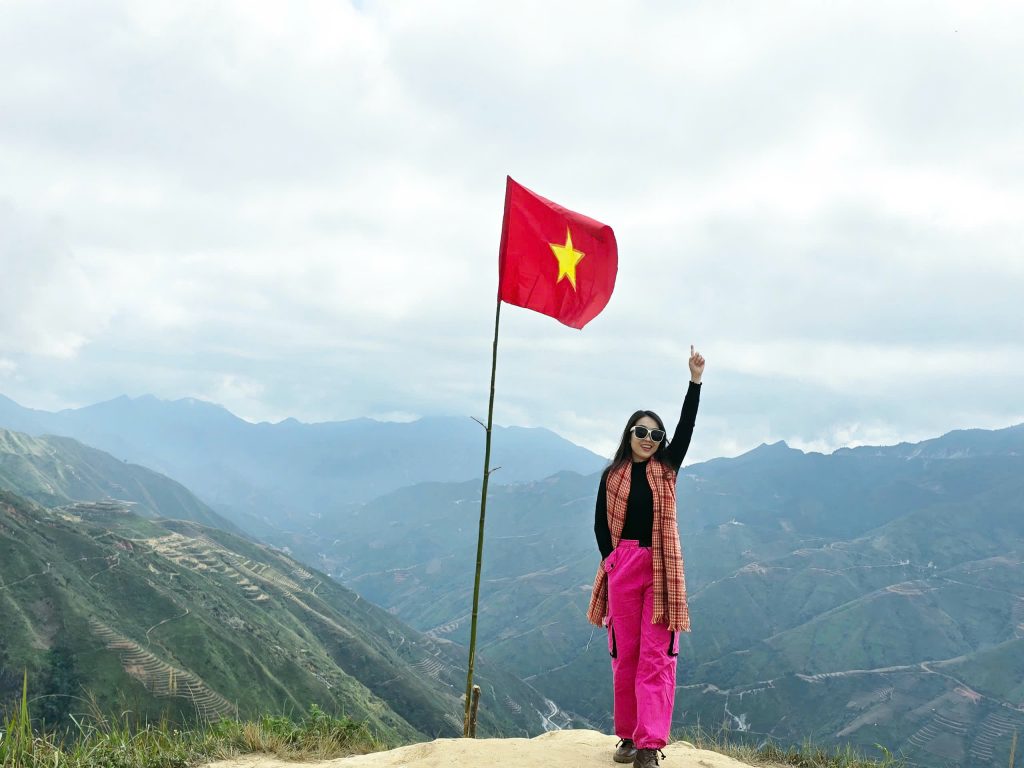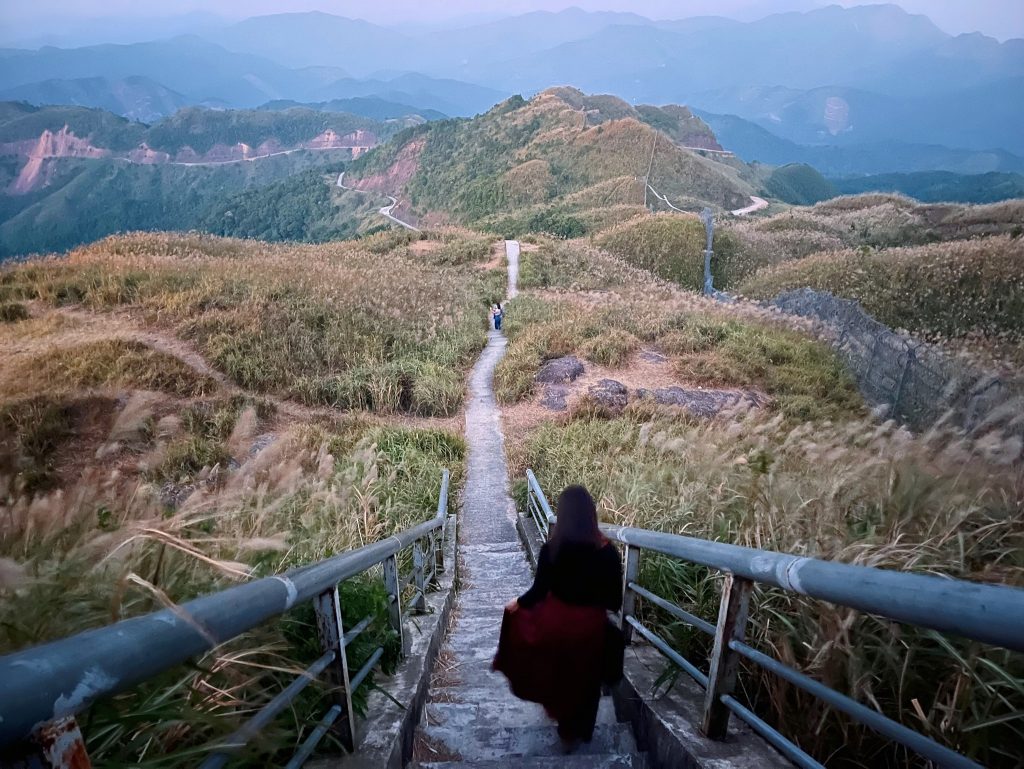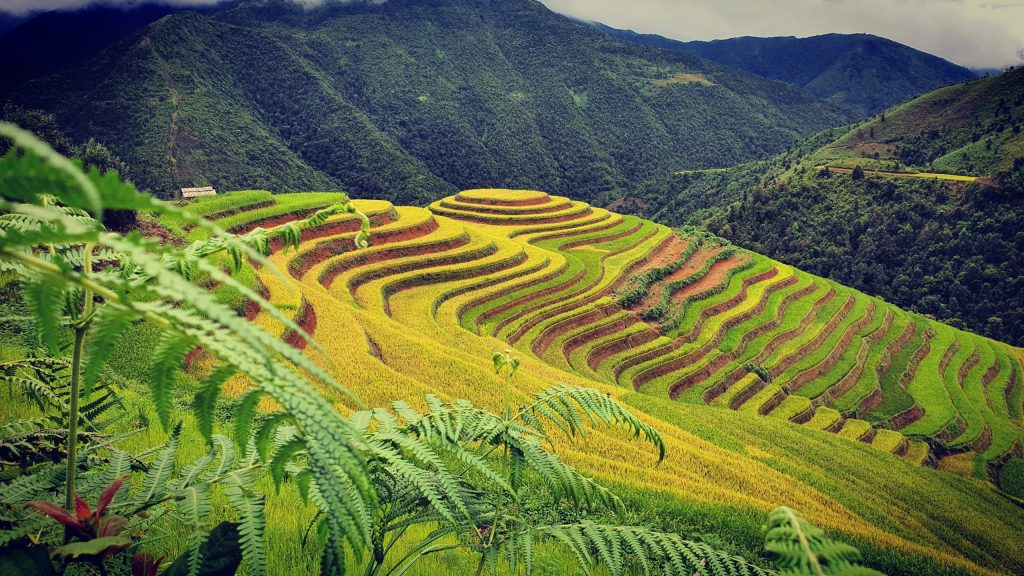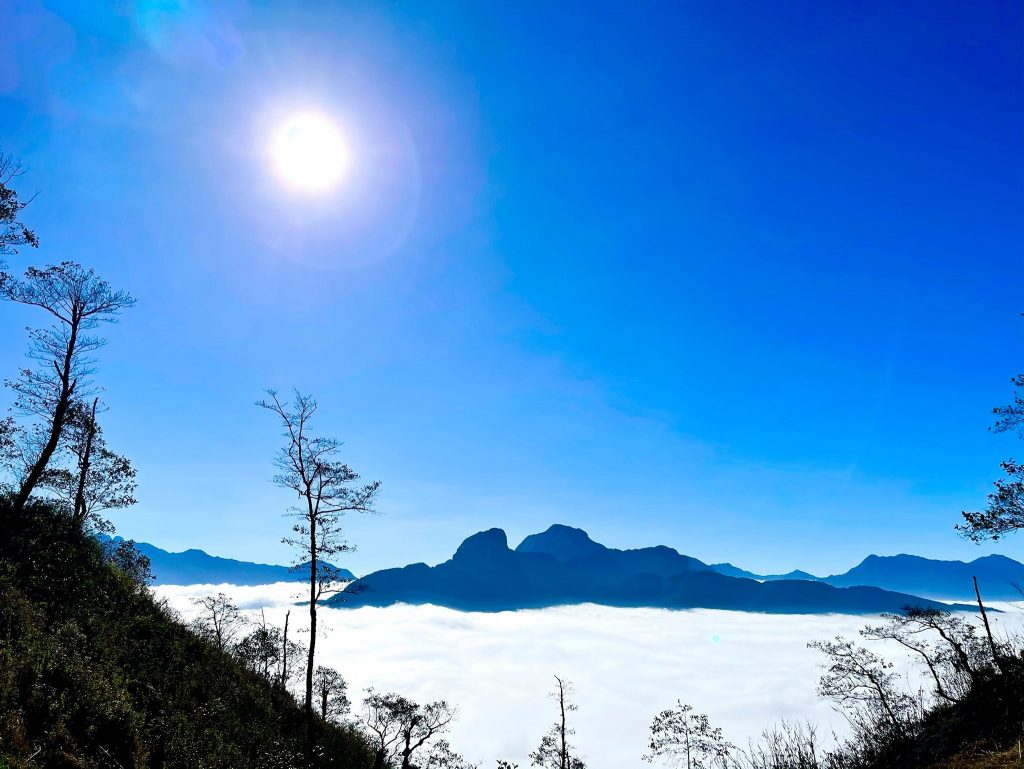Lost in the paradise Hawthorn (Son Tra/ Táo Mèo) blossoms in Nam Nghiep Village
The highland sunset melts slowly into the horizon, casting a golden glow over the misty peaks. From between the pure white forests of blooming Sơn Tra trees, a gentle trail of smoke rises from the humble homes. Somewhere nearby, the sweet laughter of Hmong children dances on the wind, as the cool mountain mist begins its slow embrace of the village…. Here, there are no honking cars, no towering buildings scraping the sky, no clamor of a hurried life — no deadlines, no weight of worldly worries.
In Nam Nghiep — the highest village in Vietnam — there is only stillness, only a tender, timeless peace.
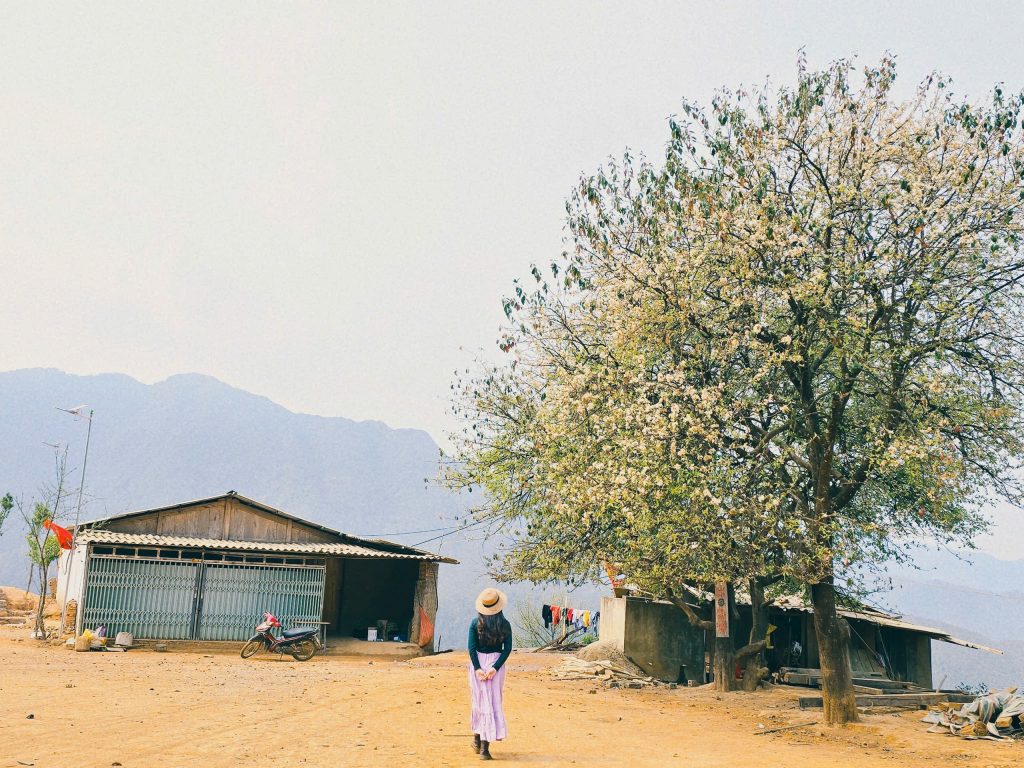
March brings spring to life across the northern highlands of Vietnam, as countless flowers burst into bloom, painting the mountains in vivid colors.
Among them, one very special flower stands out — the pure white hawthorn blossom, also known as the wild Son Tra flower (or Hmong apple flower) — blanketing the hills and valleys of Nam Nghiep Village, nestled in Ngọc Chien Commune, Muong La District.
A delicate beauty with a name as poetic as its presence, Son Tra turns the rugged highlands into a dreamscape of endless white.
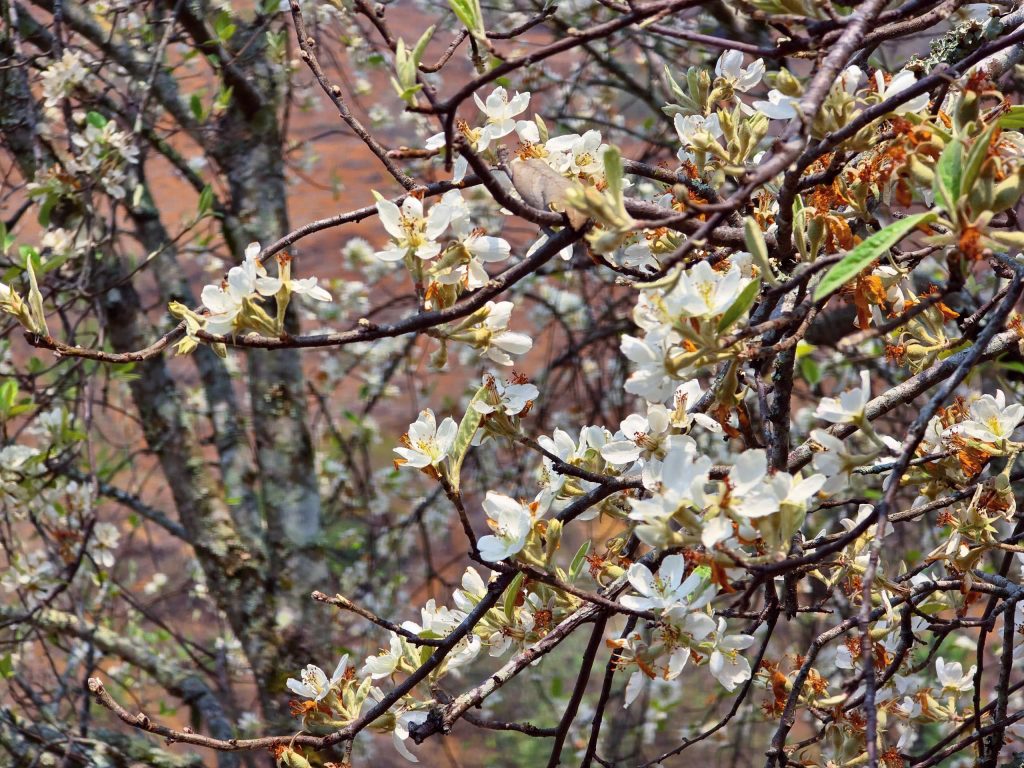
- Where is Nam Nghiep?
Located at an altitude of 2,000- 2,500 meters, Nam Nghiep is currently the highest village in Vietnam — known as the kingdom of the Sơn Tra trees. Covering a total area of about 1,260 hectares, the village is home to nearly 800 hectares of ancient Son Tra forests, with many trees aged between 300 to 500 years.
Nam Nghiep is a small, secluded village clinging to the rugged mountains of Ngoc Chien Commune, Muong La District, in Sơn La Province.
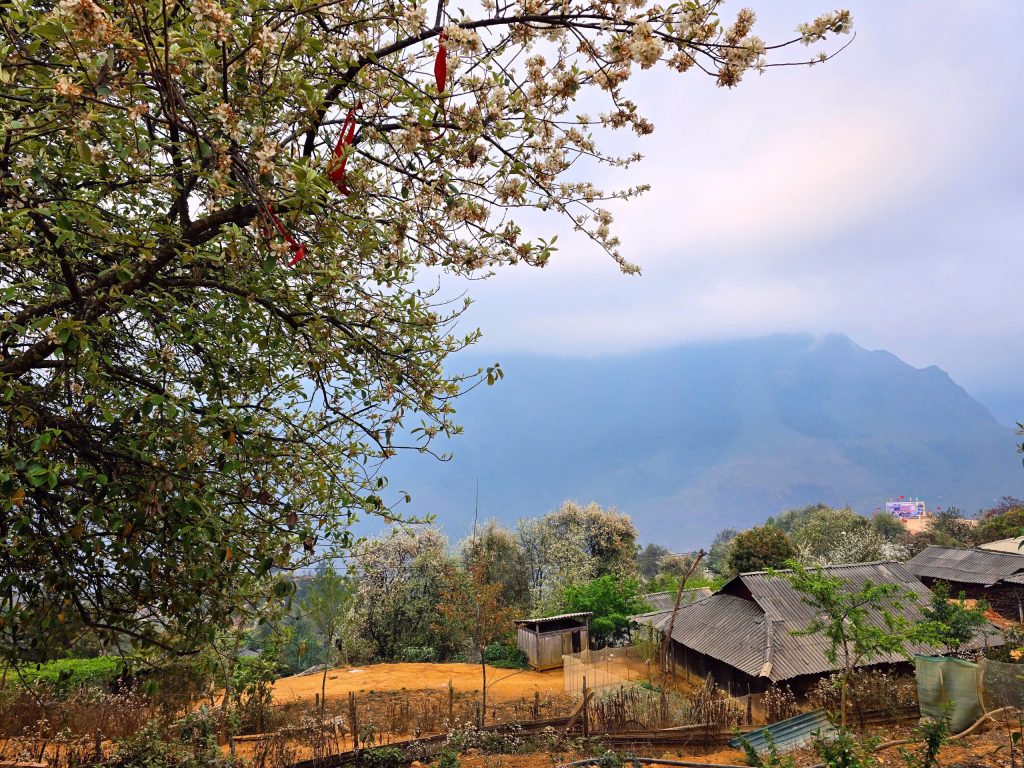
Nam Nghiep is shaped by five major family lineages: Kháng, Sùng, Thào, Giàng, and Phàng — with the Kháng being the most prominent. This mountain village is home to 135 households and over 700 residents, all belonging to the Black Hmong ethnic group.
Nestled in isolation at high altitude, Nam Nghiep remained largely cut off from the outside world until recently. Before the new concrete road was completed on March 15, 2025, life here revolved around self-sufficiency — a rhythm deeply attuned to the mountains.
Terraced rice fields spill down the steep slopes, where a hardy local rice variety has adapted over generations. Once cooked, the grains swell into large, dusky-red kernels, so robust and unusual that first-time visitors often mistake them for small beans — a simple yet extraordinary taste of life in this remote land.

Cradled along the western slopes of the Hoàng Liên Sơn range, Nam Nghiep gazes out toward Pu Luong — a towering peak rising 2,985 meters high in Tram Tau District, Yên Bái Province.
Speak of Pu Luong, and Ta Chi Nhu inevitably comes to mind — a mythical summit, beloved by mountain adventurers and those who chase the call of the heights.
Across the rugged ridges of Ta Chi Nhu, the mountains burn crimson with rhododendron blooms, softened by misty patches of violet Chi Pau flowers. On the Nam Nghiep side, a different wonder awakens: centuries-old Sơn Tra trees unfurl their snowy blossoms, spilling across the mountainsides like waves of drifting cloud.
2. When is the best time to visit Nam Nghiep?
In recent years, Nam Nghiep has begun to attract attention, thanks to mountain trekkers passing through the village on their way to conquer Ta Chi Nhu in March — the season when the entire village is blanketed in the snowy blossoms of the Sơn Tra trees, also known as wild apple flowers.
Lately, with the support of local authorities and a few kind-hearted friends from the lowlands who have fallen in love with Nam Nghiep, the villagers have been encouraged to open their doors to travelers. Step by step, they are beginning to share the story of this fairytale-like village with the world.
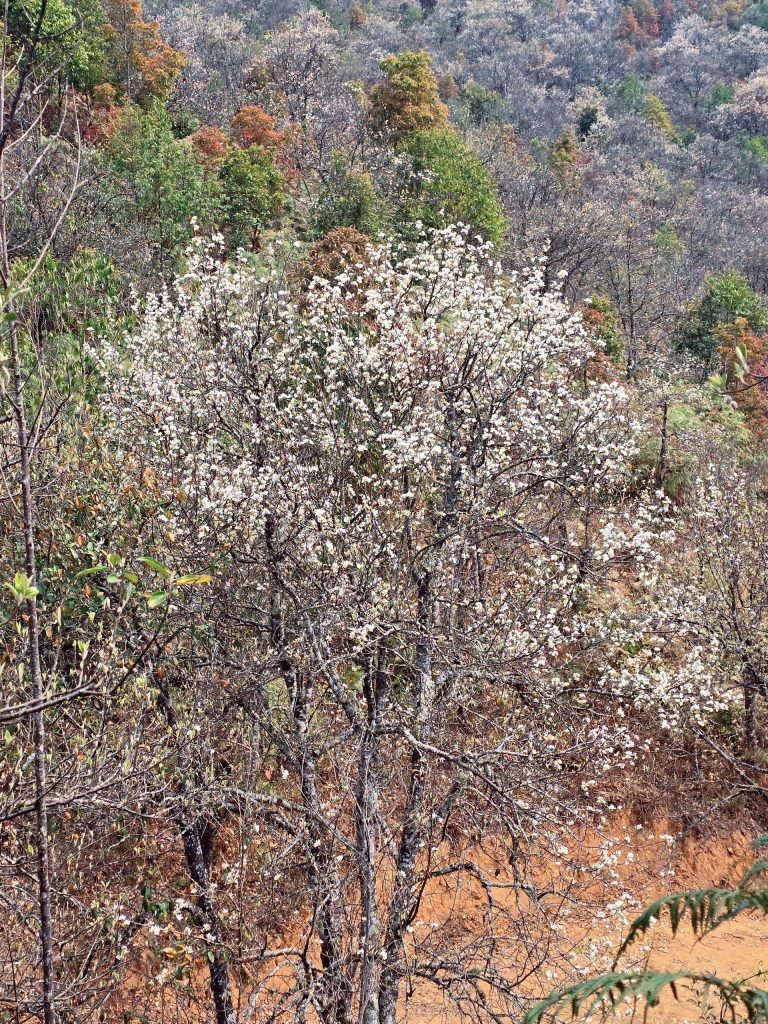
From late February, as the land awakens into spring, the first Sơn Tra blossoms begin to appear.
By mid-March, the trees reach their full bloom, dressing the mountains in their finest.
The Sơn Tra flowers of Nam Nghiep, shaped by centuries of life at around 2,500 meters above sea level, have a gentle ivory hue.
Each bloom has five delicate petals and a golden center, gathering in clusters that wrap around the rough branches, turning the ancient trees into giant snow-white sculptures.
Simple and humble in their beauty, the Sơn Tra flowers are a symbol of the enduring strength and resilience of the Hmong people.
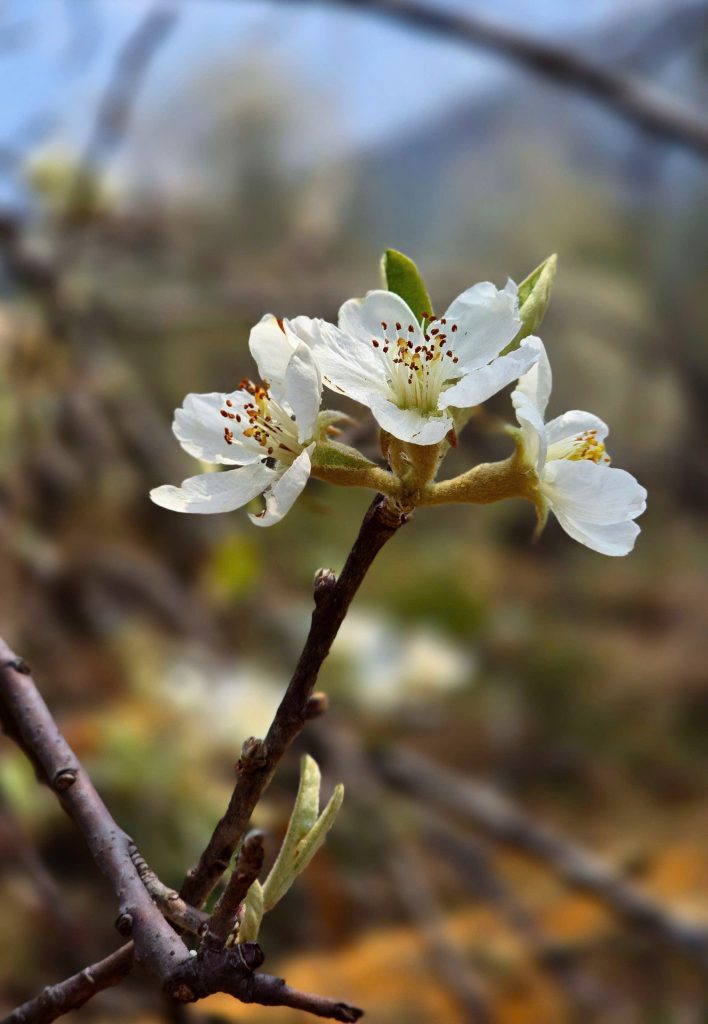
To make it easier for visitors to enjoy the Sơn Tra blossoms, Ngọc Chiến Commune has set up a task force to survey and select the best “check-in” spots among the flowering gardens.
They have chosen 10 beautiful locations for visitors to experience the blooms, including the Ancient Sơn Tra Garden, Ngam La residential area, A Lệnh Homestay, A Vạng Homestay, and The Lover Hill Café, among others.
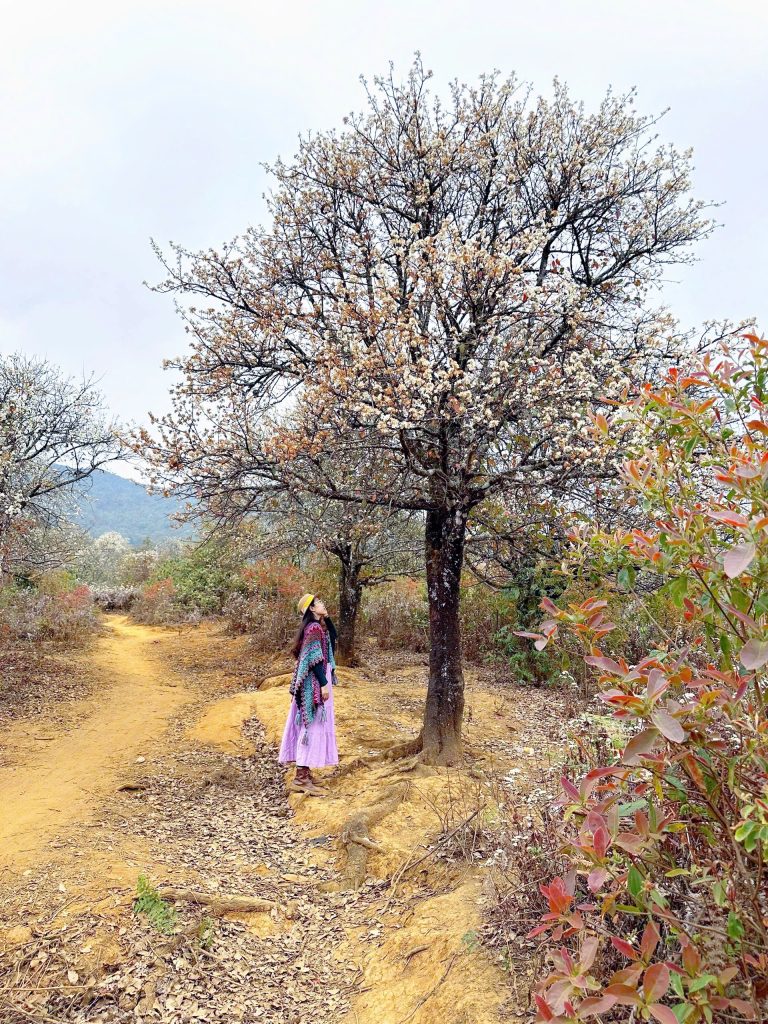
March in Nam Nghiep is not only the season of Son Tra blossoms, but also the time when the Bauhinia variegata flowers (Ban Flower) and Bombax (Silk Cotton) flowers burst into bloom.
Along the steep 10-kilometer road from Luot Village, Ngoc Chien Commune to Nam Nghiep, pale pink Bauhinia variegata blossoms sway gently in the wind, while fiery red Bombax flowers bloom brightly, lighting up quiet corners of the villages with their vibrant colors.
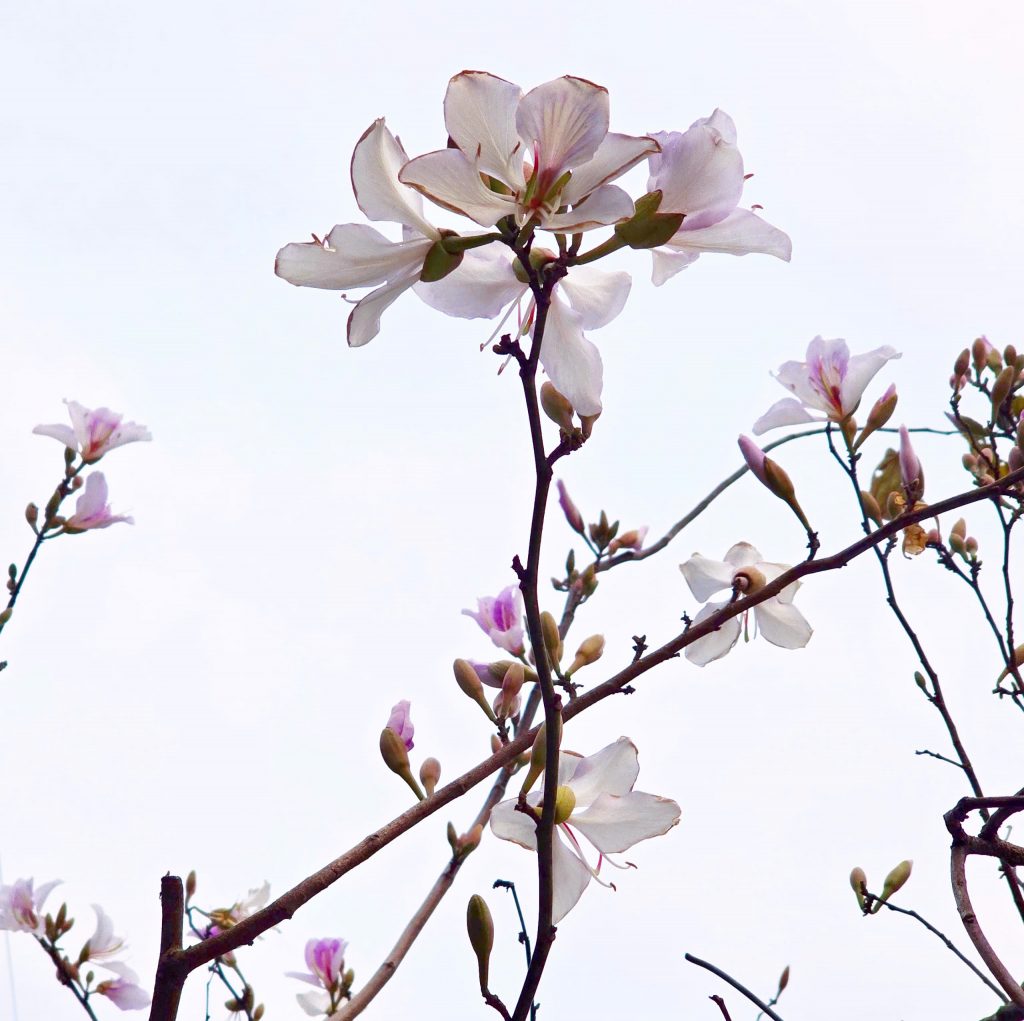
The Bauhinia variegata flowers in Nam Nghiep are exceptionally beautiful. Growing at an altitude of over 2,000 meters, the trees here almost completely shed their leaves, allowing the clusters of blossoms to burst forth in full splendor. Under the gentle spring sunlight of this distant land, the vivid pink flowers bloom with a breathtaking beauty that stirs the heart.
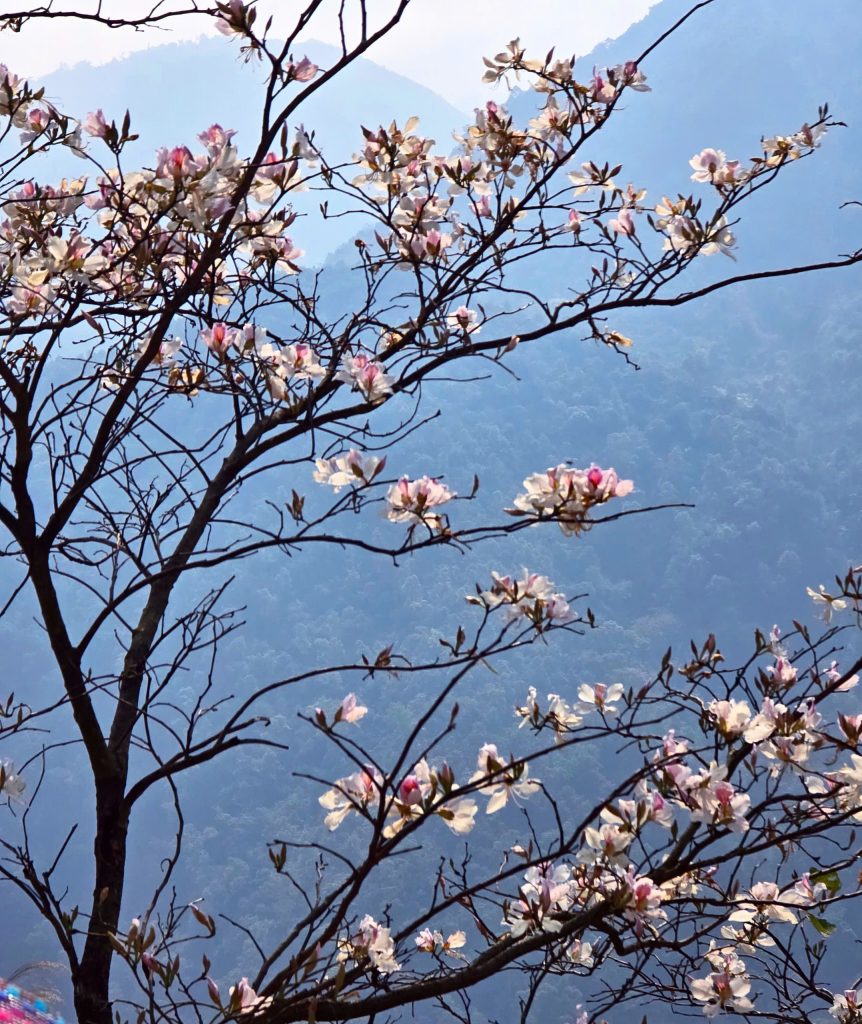
The Bombax flower, also known as the Silk Cotton flower, is a simple yet striking blossom with five large, thick petals. A unique feature of this flower is that its petals do not grow closely together, yet they all burst into brilliant bloom at the same time. Bombax flowers bloom at the end of spring, around March, marking the moment when the lingering chill of winter begins to fade, giving way to the first warm rays of summer sunlight.


Late March and early April mark the season when rhododendrons burst into full bloom on the peaks of Tà Tao and Tà Dông, painting the mountainsides with a vibrant tapestry of colors.
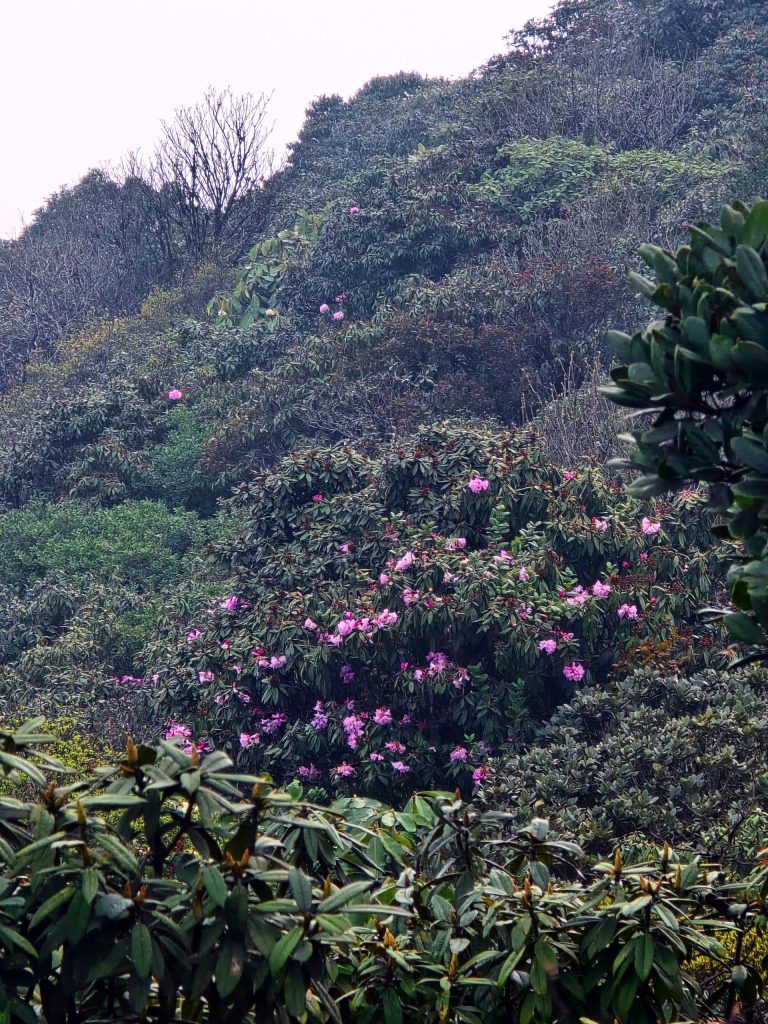
Known as the “queen of the Northwestern forests,” the rhododendron captivates with its wide range of colors — from deep, rich tones to delicate pastels.
Its petals are both fragile and wild, carrying a mysterious beauty that seems to belong to another world.
It’s no wonder that even the most determined trekkers find their steps slowing, lost in wonder as they pause to admire the blooms.
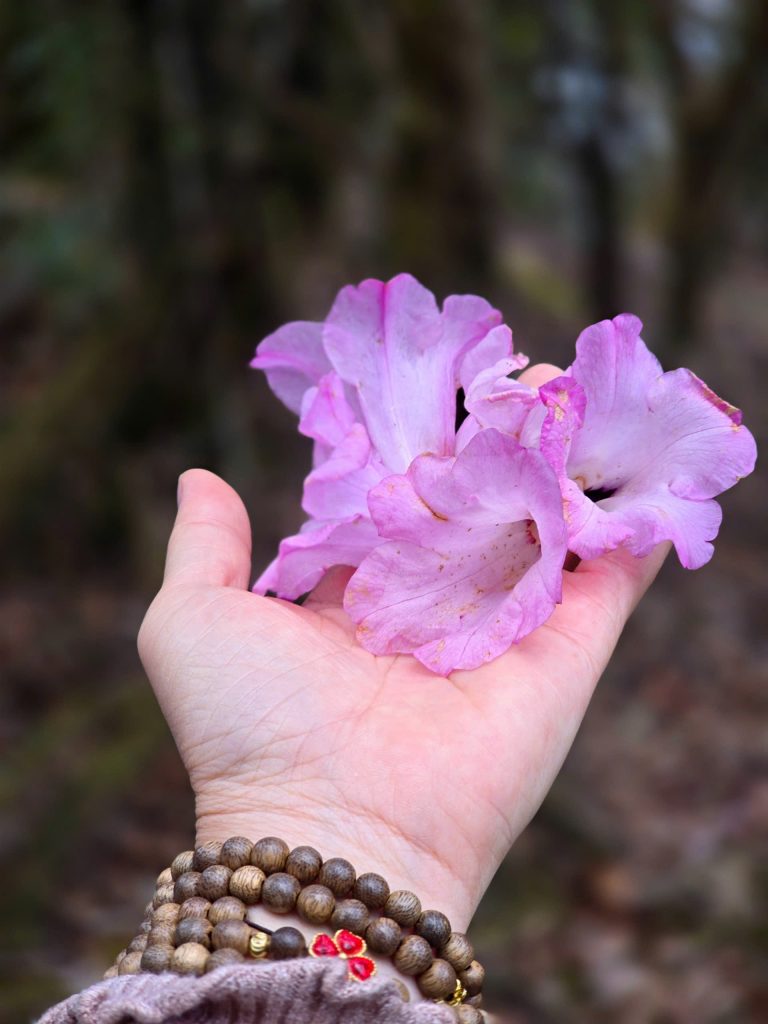

From September to October, the mountains are brushed with the delicate purple blooms of the Chi Pâu flower.
Chi Pâu usually grows at altitudes above 2,000 meters and blooms only once a year, for just about a week each autumn, across the northern highlands.
Journey to Nam Nghiep and set out to conquer the peaks of Tà Tao, Tà Dông, or Ta Chi Nhu (Yen Bai province), and you’ll find yourself awestruck — surrounded on all sides by mountains cloaked in a sea of nameless purple flowers.
.
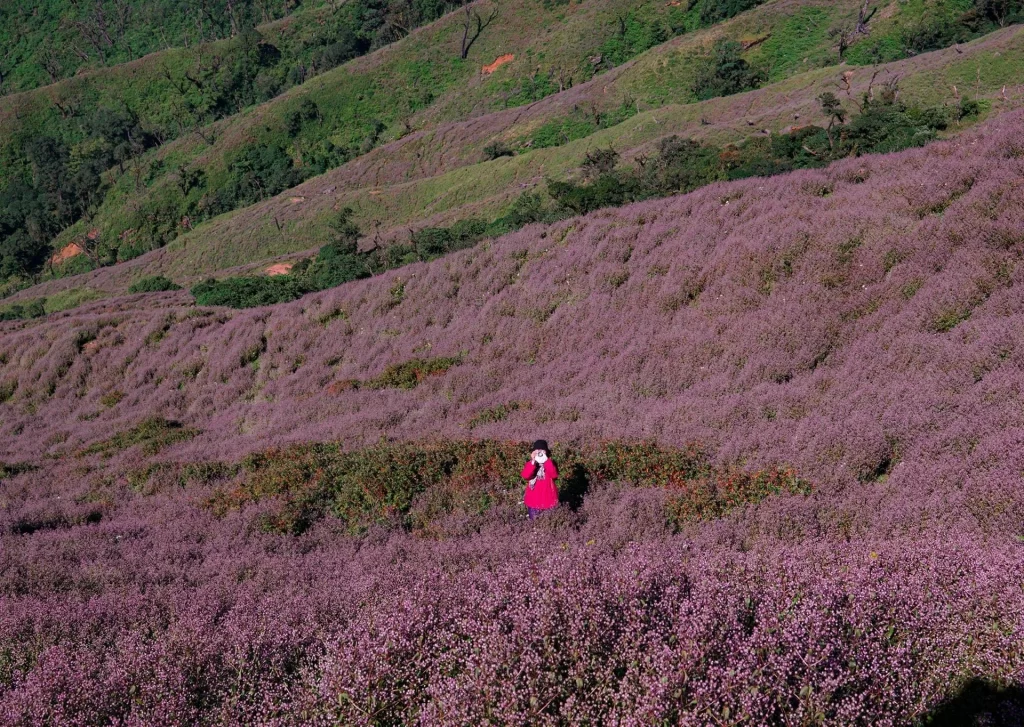

3. How to go to Nam Nghiep?
For true adventurers, riding a motorbike to Nam Nghiep is an unforgettable journey through some of Northern Vietnam’s most breathtaking mountain landscapes.
If you’re confident on winding passes and rugged terrain — and ready for a bit of a challenge — there are two main routes from Hanoi you can take:
First Route (via Moc Chau):
Ride through Moc Chau to Sơn La City (Sơn La Province), then continue toward Muong La District.
From there, head to Ngọc Chien Commune. Once you reach Ngọc Chien, it’s a final 10-kilometer stretch to Nam Nghiep — a short but steep road, full of sharp hairpin turns and thrilling climbs.
Second Route (via Nghia Lo):
Take the road through Nghia Lo Town, pass through the beautiful valleys of Tu Le (Yen Bai Province), and at Nga Ba Kim, turn left into Ngoc Chien Commune.

– Car: Renting a private car is also a great option, especially if you want to save your energy for exploring the more challenging parts of the journey. It gives you the freedom to stop wherever you like along the way — perfect for catching those unexpected, breathtaking views.
However, be aware: the winding mountain passes are steep and tricky. If you’re not familiar with driving in high-altitude terrain, or if you’re prone to motion sickness, traveling by car can be a bit challenging.
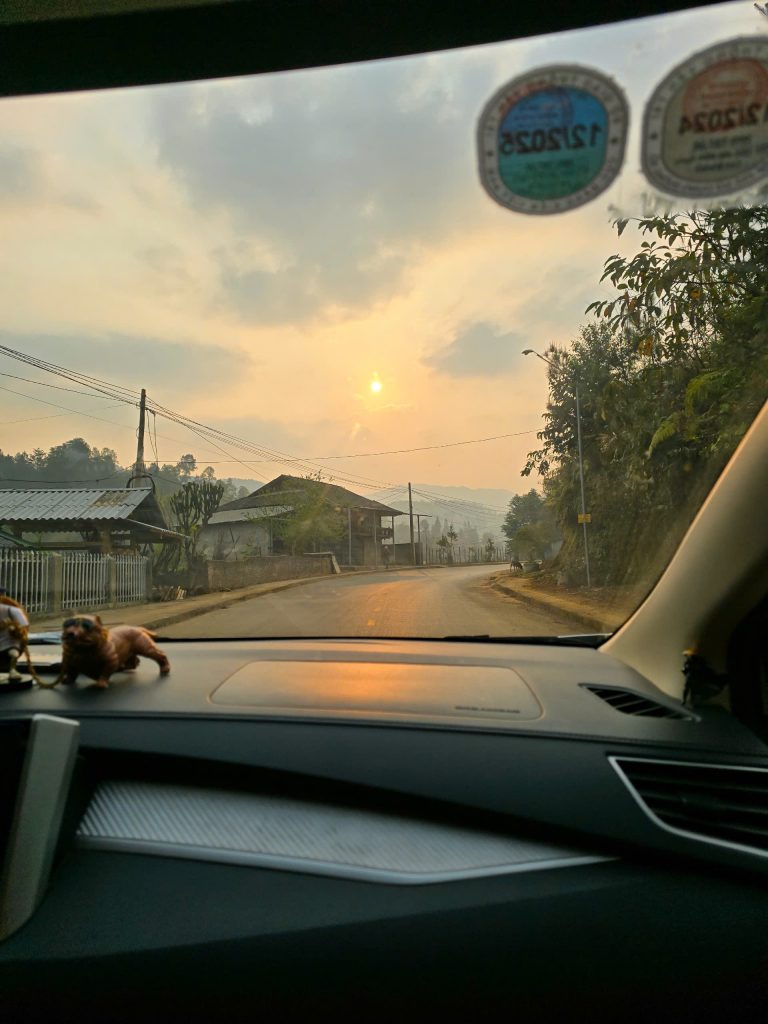
– Passenger Bus:
You can also travel by sleeper bus or limousine service. Both follow the same two routes mentioned earlier for motorbikes.
Since I took the Yen Bai route, I’ll share my experience with you based on that journey.
You can book a sleeper bus ticket with Cuong Lan (or other bus companies) from Hanoi to Nga Ba Kim (Mu Cang Chai, Yên Bái). Get off at Nga Ba Kim — there, you’ll find Hùng Nga motorbike rentals.
If you’re up for riding yourself, you can rent a motorbike here. If you prefer to save your energy for the mountains, you can also hire a taxi from Nga Ba Kim directly to Nam Nghiep. Prices are clearly listed on the “Nam Nghiep — Vietnam’s Highest Village” page, so no need to worry about getting overcharged.
– Local Motorbike Taxi (Xe Ôm):
To help support community tourism, many travelers choose to ride with local motorbike taxis from Ngọc Chien Commune to Nam Nghiep and back (about 100,000 VND per ride — and absolutely worth it!).
Prices are clearly listed, with support from the Nam Nghiep village cooperative, so there’s no need to worry about overcharging.
Riding with a local driver lets you enjoy the beautiful scenery at a relaxed pace — and it’s a wonderful way to contribute directly to the livelihoods of the people in this remote mountain region.
I chose this option during my time exploring the village, and it made the whole experience even more meaningful.

List of Bus Companies for the Mỹ Đình – Ngã Ba Kim – Ngọc Chiến Route:
- Thế Anh: 0816985985
- Kiên Huyền: 0976176355
- Thảo Nguyên: 0961853385
- Gia Khánh: 0963788599
Note: The Thảo Nguyên bus goes directly into Ngọc Chien, but you’ll need to transfer to a smaller vehicle for the final stretch.
If you want to rent a 7-seater car to reach the village, you can call the Nam Nghiep Cooperative Hotline: 0904898688.
For motorbike rental in Ngọc Chien ( Lướt Village area), contact: 0383055407.
Local taxi service: Taxi Nam: 0833502974.
Pro Tip:
To save time, you can take a night bus.
Cường Lan Bus picks up around 11:30 PM (opposite Thuongmai University in Hanoi).
Phone number: 0961357799.
You’ll arrive at Nga Ba Kim around 5:30 AM — perfect for renting a motorbike and riding up to Nam Nghiep.
Motorbike rentals:
- Hùng Nga: 0387248888
- Hải: 0965288818
4. Staying in Nam Nghiep: Accommodation Guide
Depending on your itinerary, you can choose a homestay that fits your journey.
If you’re following Kame’s suggestions, it’s highly recommended to experience staying in both Luot village (Bản Lướt) and Nam Nghiep Village (Bản Nậm Nghiệp).
These days, the local communities have been encouraged to develop more proper homestay services.
While they might not yet match the standards of more famous tourist destinations, Kame actually found them incredibly charming — simple, warm, and full of authentic mountain spirit.
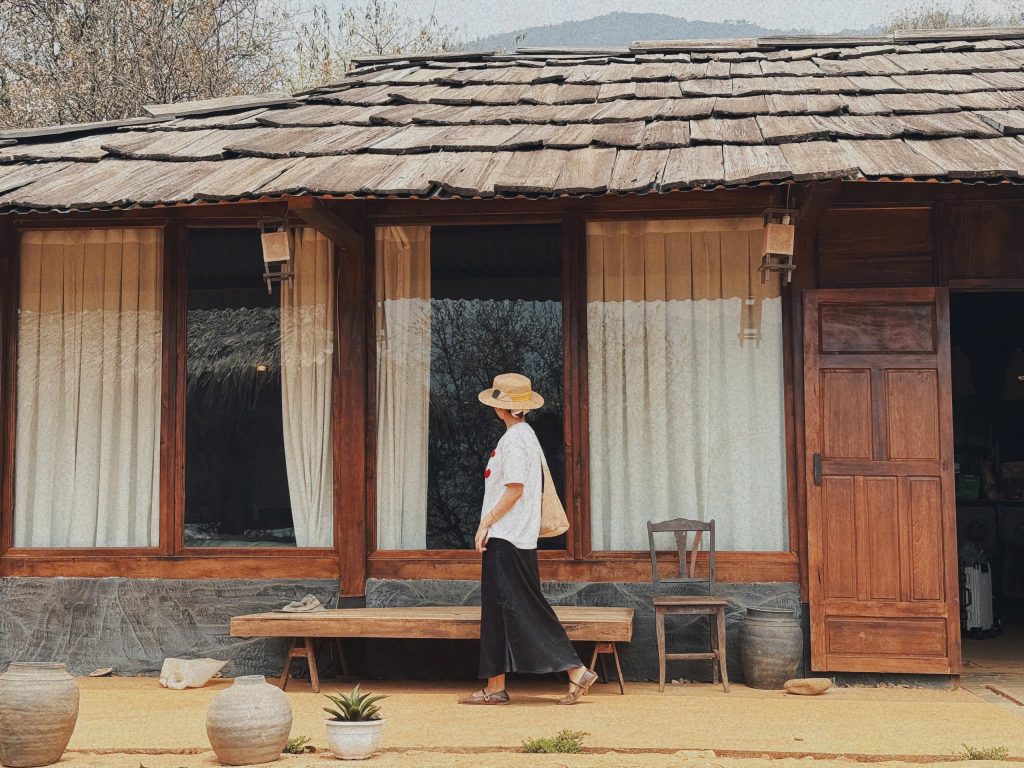
In Luot Village (Bản Lướt – Ngọc Chien), where the Thai ethnic community lives, most homestays are traditional wooden stilt houses or large communal houses. It tends to be a bit livelier and noisier, but the bonus is the wonderful natural hot springs nearby — perfect for relaxing.
Meanwhile, in Nam Nghiep Village (Bản Nậm Nghiệp), there’s a wider variety of homestay options, including community dorms, private bungalows, and even camping experiences right in the middle of ancient Sơn Tra flower forests.
The prices below are for reference — actual rates might vary slightly depending on the season:
♥️ Private standard room for 2 people with an ensuite bathroom: around 600,000 – 800,000 VND/night.
Luxury private room: about 1,000,000 VND/night.
♥️ Private standard room for 4 people with 2 beds and ensuite bathroom: about 1,000,000 – 1,200,000 VND/night.
Luxury 4-person room: around 1,500,000 VND/night.
♥️ Cabin-style private room for 2 people: around 300,000 VND/night.
♥️ Shared community dorm bed, bathroom outside: around 120,000 – 150,000 VND/night.
♥️ You can find homestays in Bản Lướt, Đông Xuông, Nà Tâu, and Nậm Nghiệp.
For more details, contact the Nam Nghiep Cooperative Hotline: 0904898688.
- Homestay Hương Rừng – Đông Xuông Village.
- Ngoc Chien Pearl Homestay – Nà Tâu Village
- Hoàn Hậu Homestay – Lướt Village
- Mạnh Phương Homestay – Lướt Village.
- A Lệnh homestay – Nam Nghiep Village.
- A Vạng homestay – Nam Nghiep Village.
- A Gạng Homestay – Nam Nghiep Village.
- Sơn Tra Forest – Nam Nghiep Village.
A few notes: On weekends during Sơn Tra flower season, most accommodations here are usually fully booked. It’s best to reserve your room early or plan your trip for weekdays to make sure you have a place to stay. If you have your own tent, that’s a great option too! Camping under the ancient Sơn Tra trees in Nam Nghiep is an unforgettable experience. Just remember — nights can get very cold, so be sure to bring a warm sleeping bag.
5. Tasting Nam Nghiep: What’s on the Menu?
In Nam Nghiep, Lướt Village (Ngoc Chien), or Nà Tâu village, you can easily ask your homestay hosts to prepare meals for you.

You don’t need to worry about the flavors not suiting your taste. The cuisines of the Thai and Hmong people each have their own charm. Hmong meals are simple and rustic — mostly grilled dishes with gentle, uncomplicated flavors that are easy to enjoy. Meanwhile, Thai cuisine is more intricate and colorful, offering a wider variety of tastes and aromas.
If you come in March, you might be lucky enough to savor a special treat: the ban flower salad (Bauhinia variegata) made by the Thai people — a dish as delicate and surprising as spring itself.
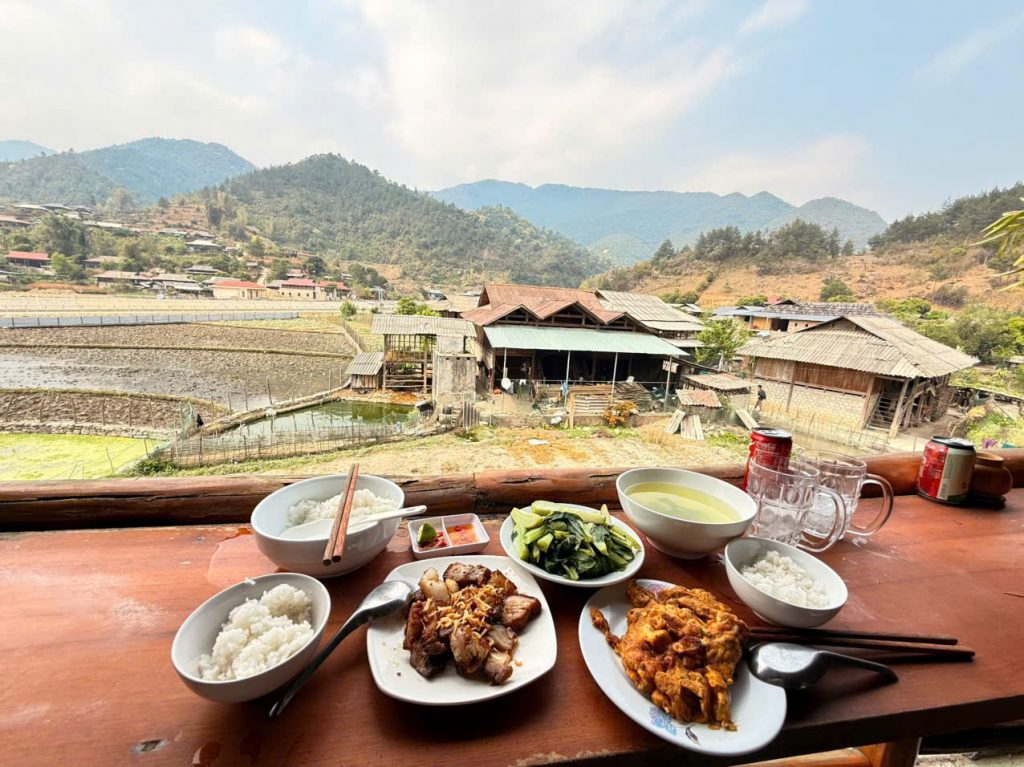
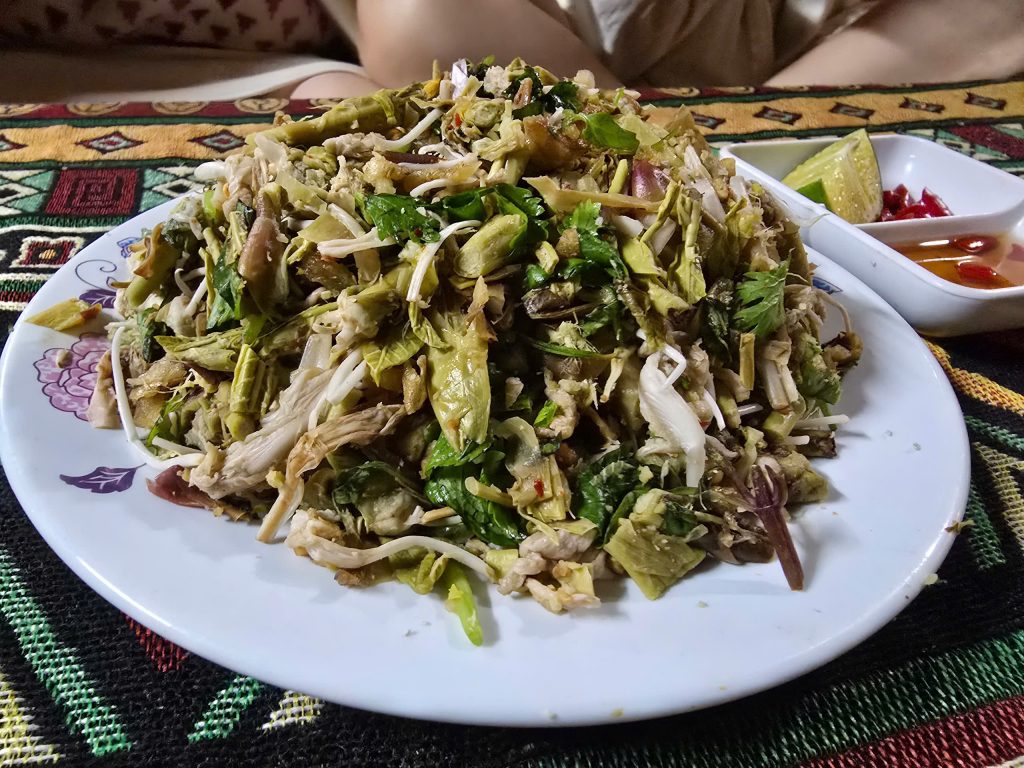
6. Detailed schedule 3 Days 3 Nights Itinerary to explore Nam Nghiep:
Day 1: Ho Chi Minh City – Hanoi – Nga Ba Kim (Yen Bai Province)
– Catch a flight from Ho Chi Minh City to Hanoi at 6:30 PM.
– Land at Noi Bai Airport around 8:30 PM, then head into the city center near the meeting point with Cường Lan bus service.
– Have dinner and wait for the bus pick-up at Hanoi’s Thuongmai University.
– The bus departs around midnight, and you’ll arrive at Nga Ba Kim at about 6:30 AM the next morning.
Day 2: Nga Ba Kim (Yen Bai) – Lướt Village (Ngoc Chien) – Nam Nghiep – Trekking Tà Tao Mountain
The Cường Lan sleeping bus drops passengers off right in front of the Hùng Nga motorbike rental shop at Nga Ba Kim (Yen Bai province) around 6:30 AM.
From there, I had arranged a taxi to take us straight to Lướt Village, to Pơ Mu Homestay. The drive covers about 30 kilometers and takes around 40 minutes.
We checked into the homestay around 8:00 AM. Normally, check-in time is at noon, but the hosts kindly allowed us to leave our luggage and freshen up there.
Our team split into two groups for the day: two friends who weren’t quite up for a mountain trek stayed behind at Lướt Village. They rented motorbikes to explore Lướt Village and Ngọc Chien at a more relaxed pace.
As for me, I chose the more adventurous path — taking a local motorbike taxi up to Nam Nghiep to start the trek to Tà Tao Mountain.
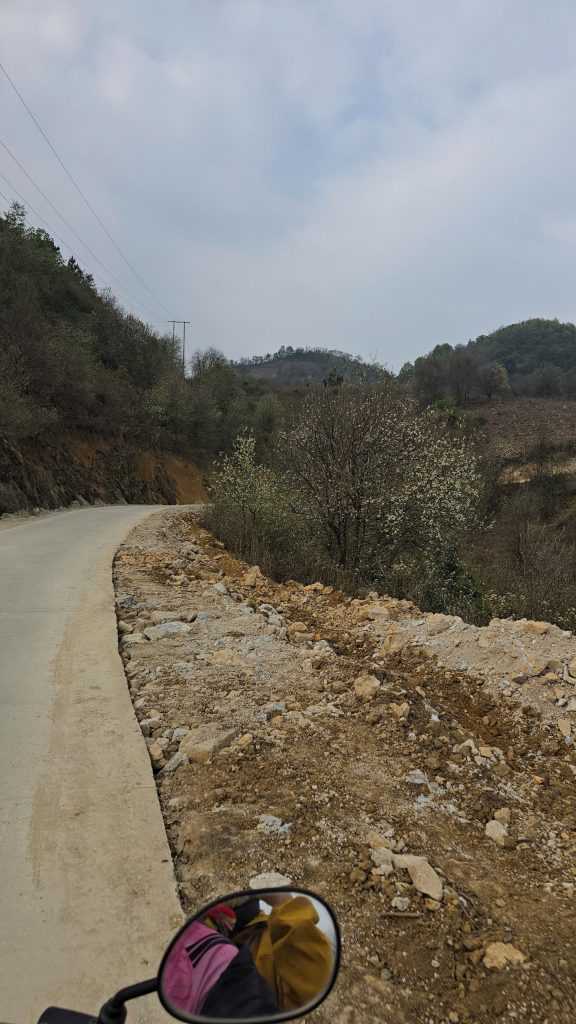
For the day’s adventure, I booked a trekking tour through Mr. Cường Nguyễn, the head of the Nậm Nghiệp Cooperative. I was lucky to be paired with Giàng Thị Viên, a 19-year-old Hmong porter from the village. Full of warmth and energy, she may not yet speak fluent Vietnamese, but her kindness, determination, and bright spirit easily bridged any language gaps.

Rising 2,720 meters above sea level in Ngọc Chien Commune, Muong La District, Son La Province, Tà Tao Peak stands among the higher summits of the majestic Hoang Lien Son Range. A hidden gem for mountain lovers, it calls out to those seeking both adventure and breathtaking beauty. With its stunning landscapes, a relatively short trail, and a moderate level of difficulty, Tà Tao is a perfect choice even for first-time trekkers — an inviting gateway to the wonders of the wild.

The trail to the summit of Tà Tao stretches about 6 kilometers, beginning right from the heart of Luot Village. The first leg — around 3 kilometers — winds steeply uphill, twisting through rocky patches and small streams, making it a real challenge even for motorbikes. From the point where the bikes are left behind, it’s just you and your own two feet, as the adventure truly begins.

The narrow, rugged trail, lined with jagged stones and steep slopes, coupled with the ever-shifting weather, quickly puts both endurance and willpower to the test. Along the journey, I found myself immersed in the simple, unhurried rhythm of local life — capturing fleeting moments, breathing in the pure, untouched beauty of the mountains.
There was no phone signal (only the rare flicker), just the murmur of mountain streams, the call of distant birds, the soft whisper of insects hidden in the undergrowth. The very breath of the forest surrounded me — the scent of moss, of wildflowers — all blending into a delicate symphony of the highlands.
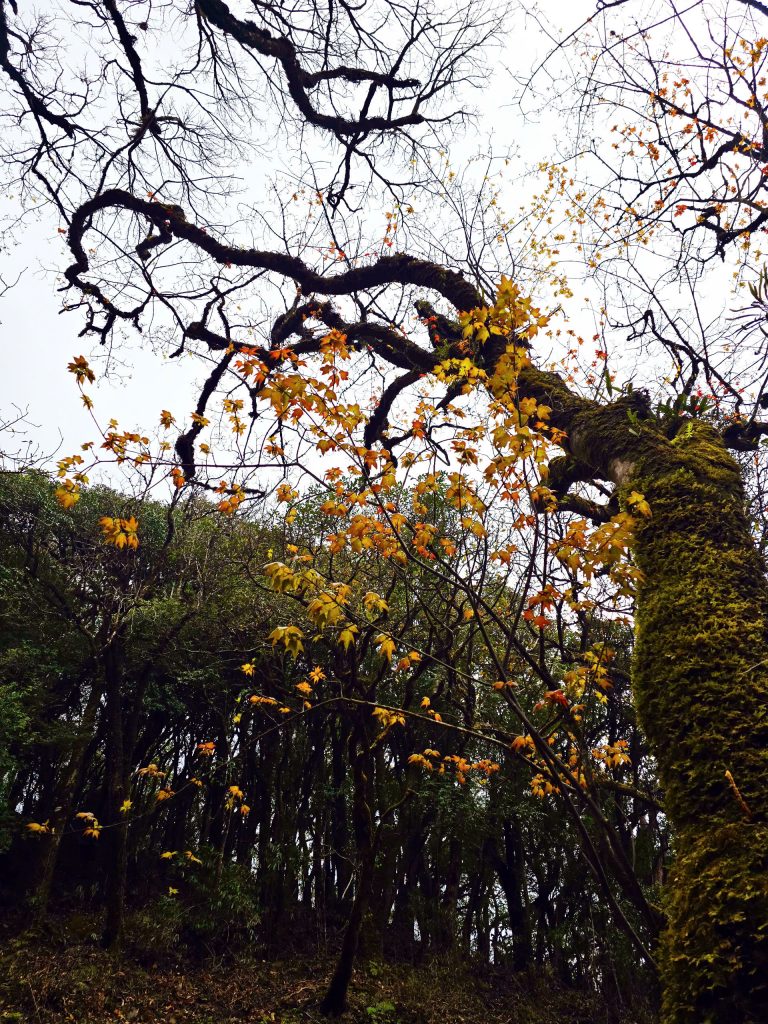
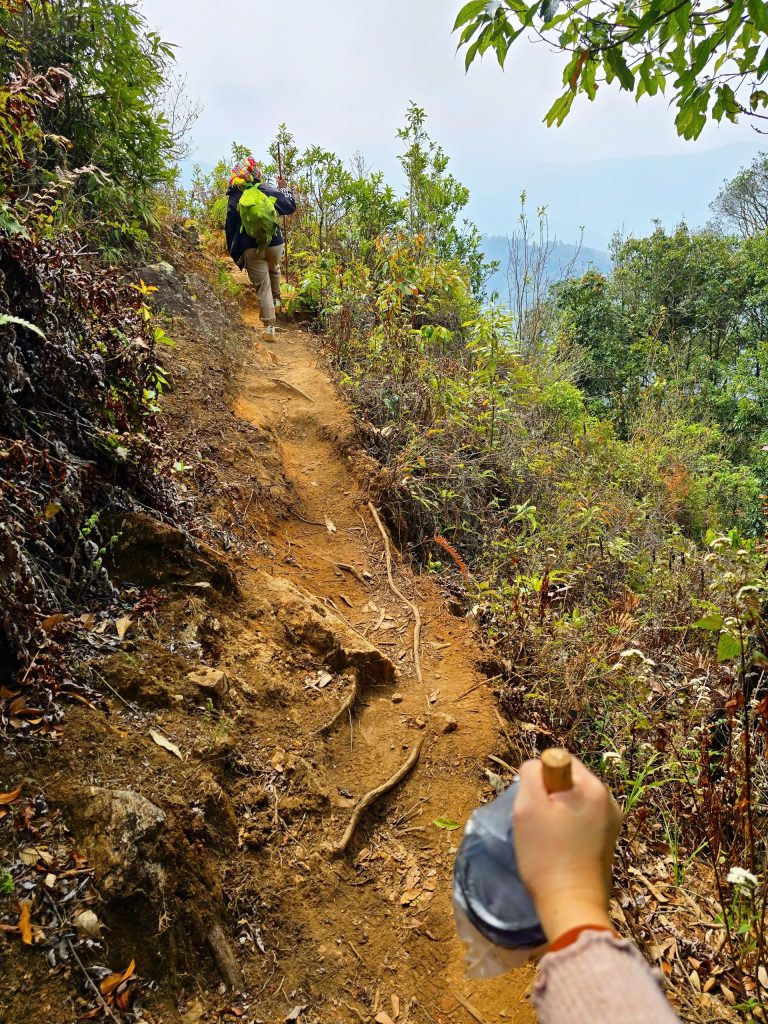
Hidden deep within the forest stand ancient, towering trees with magnificent, otherworldly shapes, their trunks cloaked in thick layers of moss — living testaments to the endurance of time. As I ventured further into the old-growth forest, the vegetation changed; the journey grew more arduous as the trail narrowed and steepened sharply. Each step felt heavier, almost no longer my own, breath growing short. The wide blue sky slowly disappeared, giving way to the dense, shadowy canopy of the untouched primeval forest.
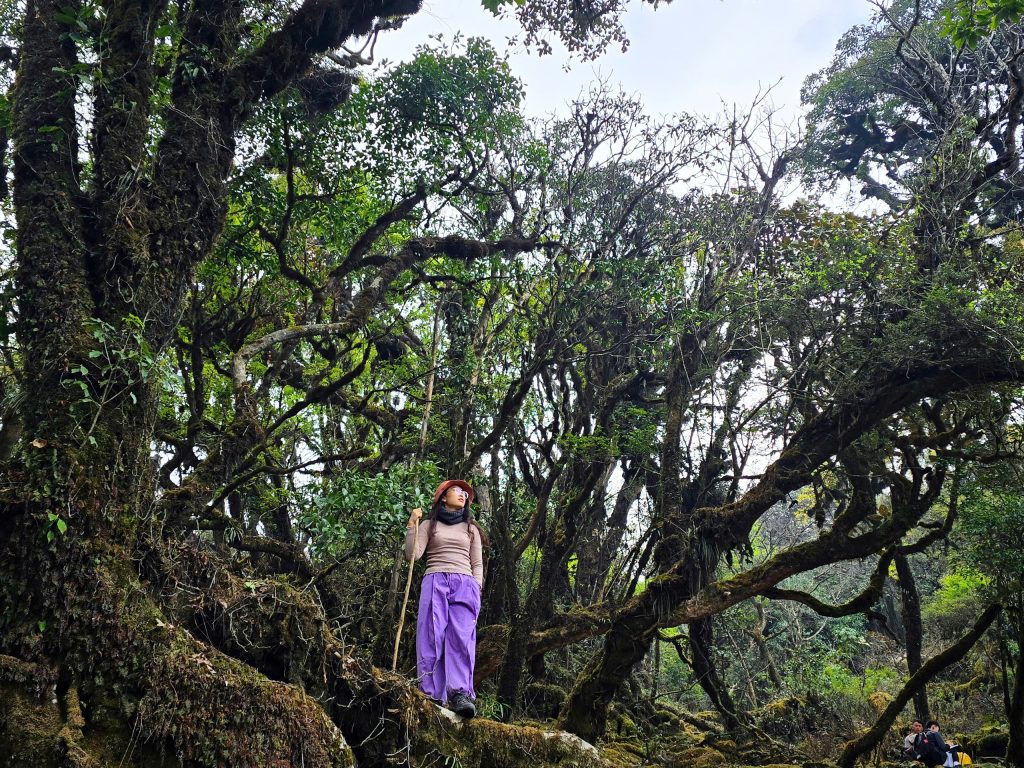
Throughout the journey, my porter, Ms. Viên, patiently and wholeheartedly led the way — always ready to support and lend a helping hand, patiently waiting as I struggled, tumbled, and crawled my way up the steep, relentless slopes.
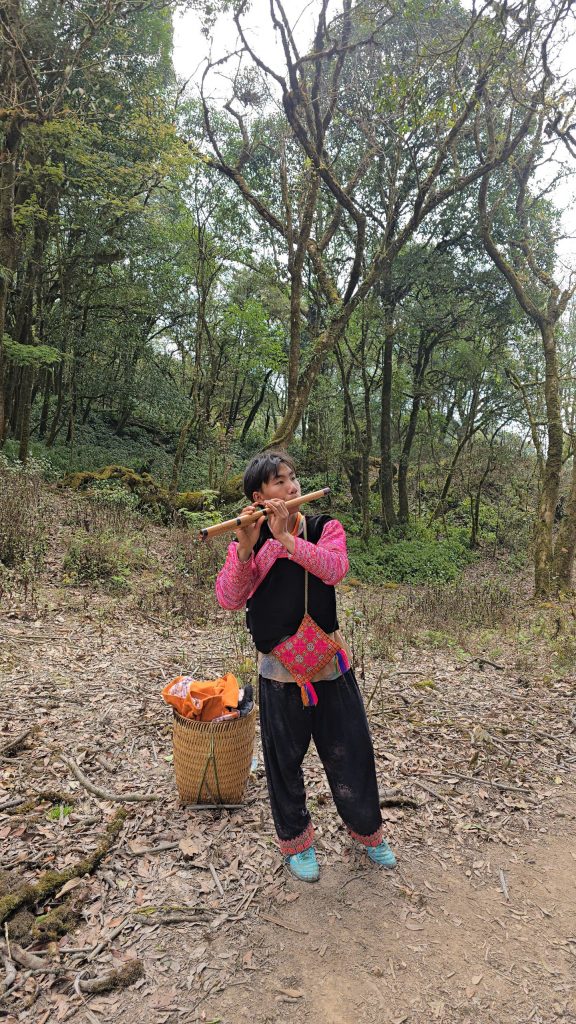

Halfway up the mountain, we came across Viên’s husband, who treated us to a performance on his bamboo flute — the very skill that had won over the young porter girl when she was just seventeen, marrying the talented Hmong boy. The soft, melodic sounds of the flute and leaf-horn drifted through the mountains and forests, as if breathing new strength into those making their way toward the summit of Tà Tao Mountain.
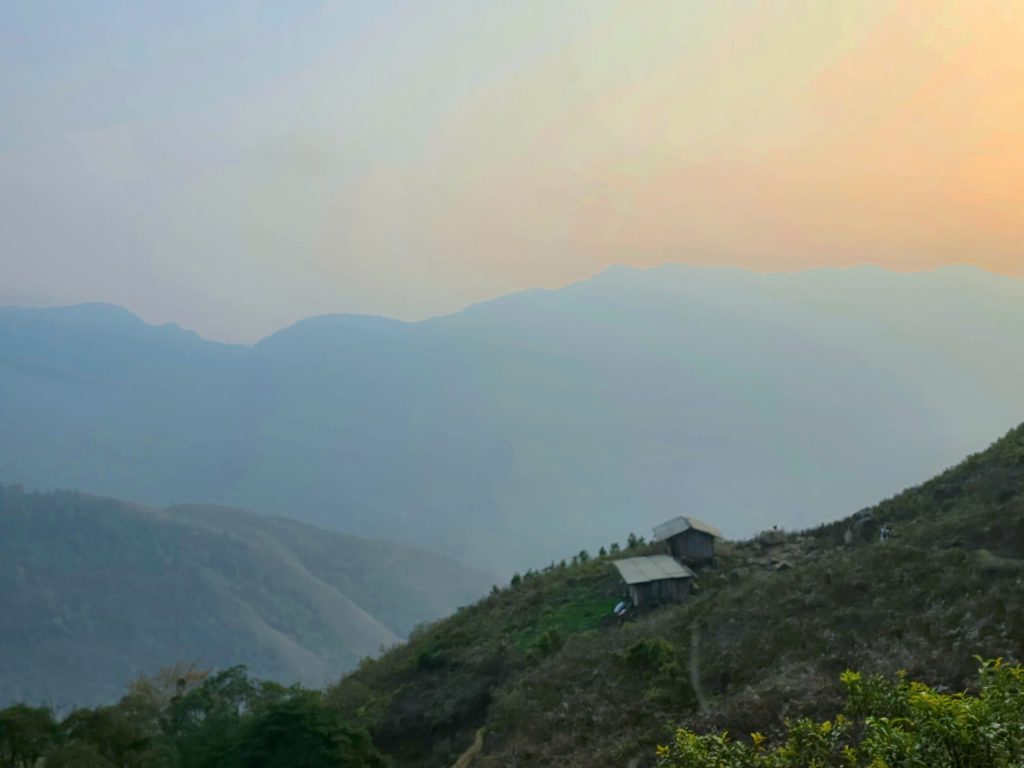
My weary legs refused to cooperate, and it wasn’t until after 6 p.m. that I finally made it back to Nam Nghiep Village. From there, I rode a motorbike down the steep 10 km mountain pass back to Luot Village, taking nearly an hour. The road was dark, steep, and treacherous, forcing me to move much slower than in the morning. After saying goodbye to Viên, my kind-hearted porter, I soaked in a hot mineral spring bath at the homestay, letting the warmth wash away the exhaustion from a long day conquering Tà Tao.
Day 3: Luot Village (Ngoc Chien) – Nam Nghiep Village
After breakfast and checking out from Pơ Mu Homestay in Ngọc Chiến, our team was picked up and headed toward Nậm Nghiệp Village. Since we had quite a bit of luggage, we opted for a taxi ride for safety. Even so, the car had to work hard, constantly shifting gears to conquer the steep, twisting mountain road, where two cars could barely squeeze past each other.
Although our check-in time at Sơn Tra Forest Homestay in Nam Nghiep was at noon, we dropped off our bags early and set out to explore. Thanks to arrangements made earlier with Viên, our cheerful local porter, motorbike taxis were ready to pick us up right at the homestay. We spent the day riding through the village, discovering hidden gems like the legendary Lone Apple Tree and the enchanting apple forests of Tà Dê…

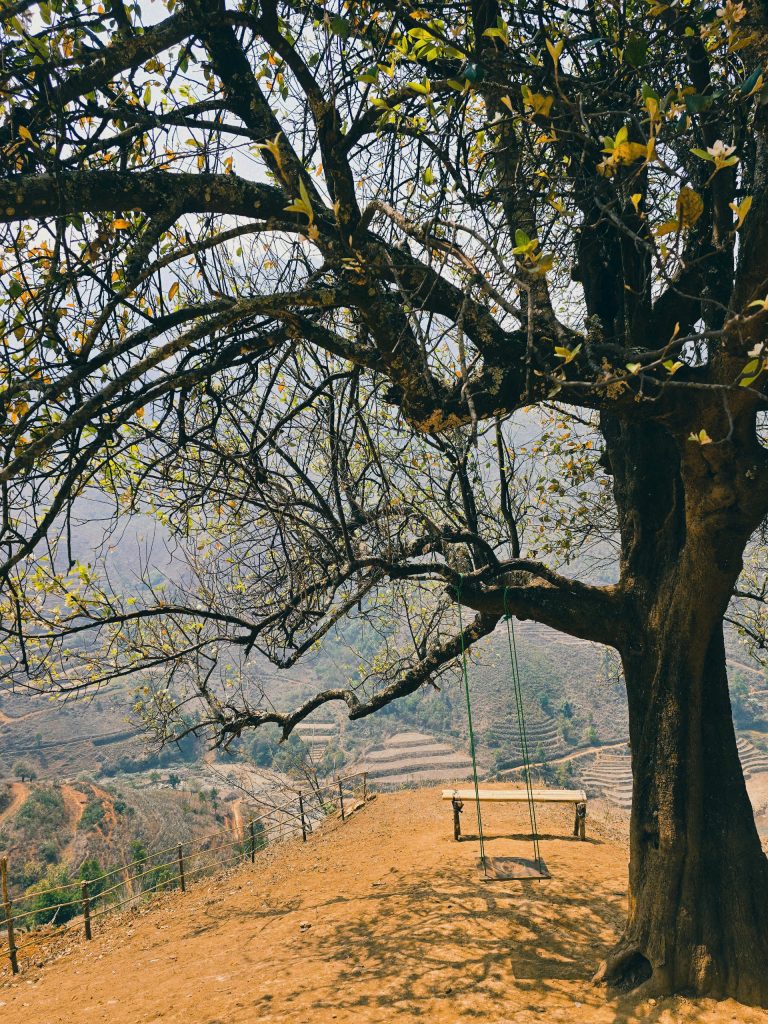
You can choose from a wide variety of local tours organized by the Nam Nghiep Cooperative. There are about 20 different experiences available, from mountain trekking, hiking, and beeswax painting to cloud hunting and flower picking.
The gentlest option is a peaceful walk under the pure white canopy of Son Tra trees, following the murmuring stream. The narrow trails winding along the hillsides of hawthorn (wild apple) forests feel like a path into a fairytale — as if you’ve quietly slipped out of the real world without even realizing it. All that remains are the songs of the birds, the whispers of the stream, and the sunlight dancing across the hills.
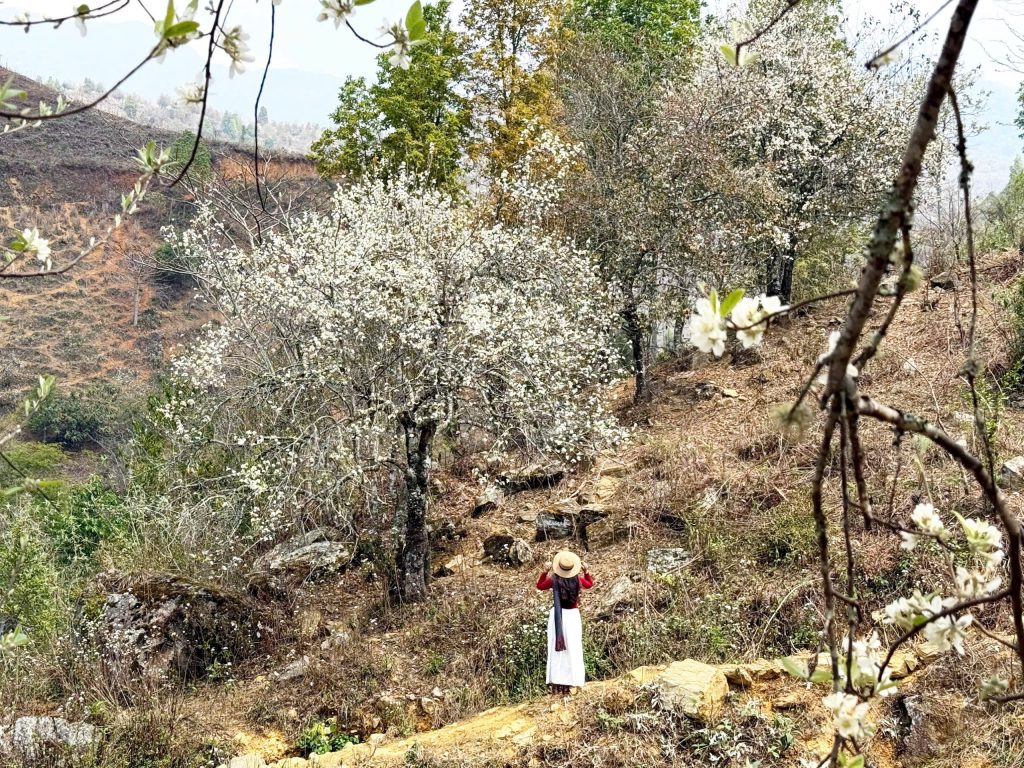
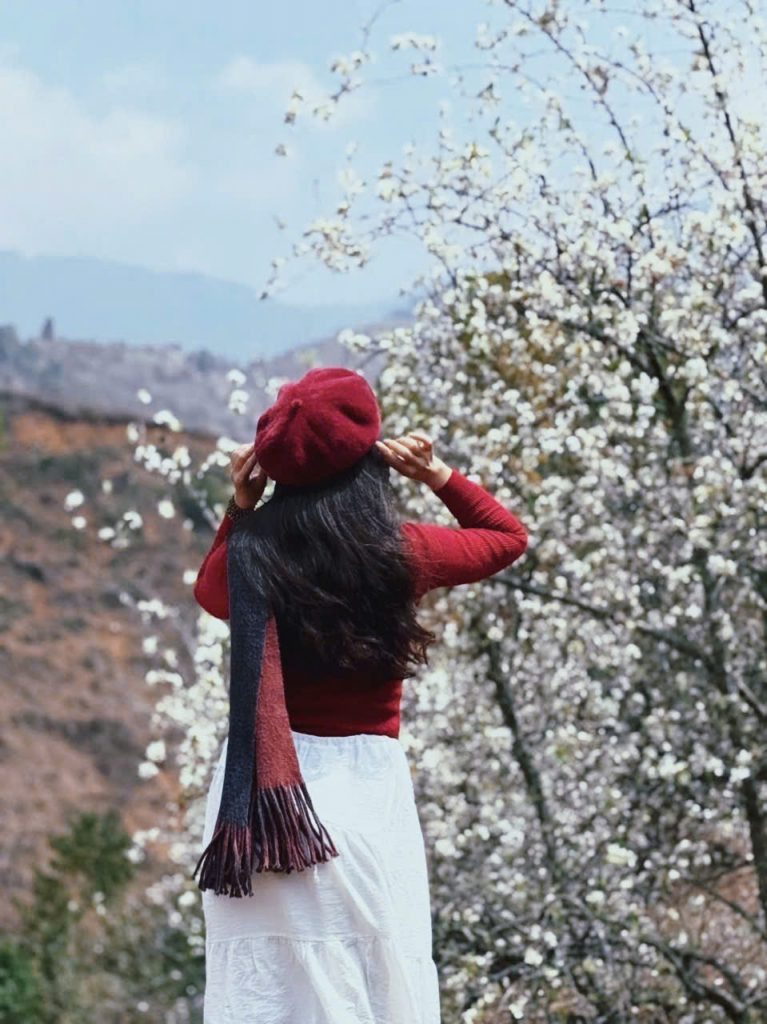
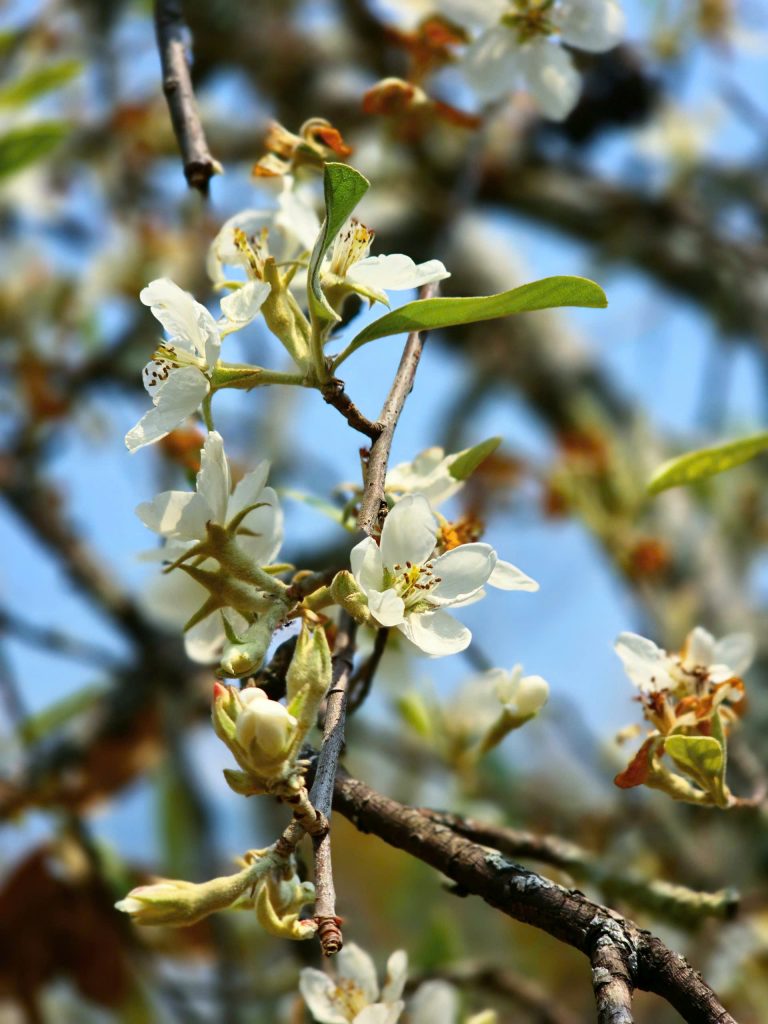
At 1 PM, we made our way to Viên’s house for a cozy lunch with her family, savoring the simple yet heartwarming flavors of the highlands.
By 2 PM, it was time to retreat to the homestay for a little well-earned rest.
Around 4 PM, our motorbike team swung by again to pick us up for something truly special — a golden hour trip to The Lover Hill Café, owned by Mr. Cường. For someone hopelessly in love with coffee like me, sipping a warm cup here felt like pure magic — a rare and precious moment, as coffee isn’t a common indulgence in Nam Nghiep. Even condensed milk is considered a rare treasure, often unavailable even if you’re willing to pay for it.
Nam Nghiep has only recently opened its arms to travelers. Life here remains beautifully simple, self-sufficient, and untouched by the hustle of the outside world.
When you visit, come with an open heart. Embrace the slower pace, the rustic charm, the small imperfections — and in return, you’ll find yourself stepping into a place that feels like it has been hidden away just for you. A place where time slows down, and the soul breathes free.

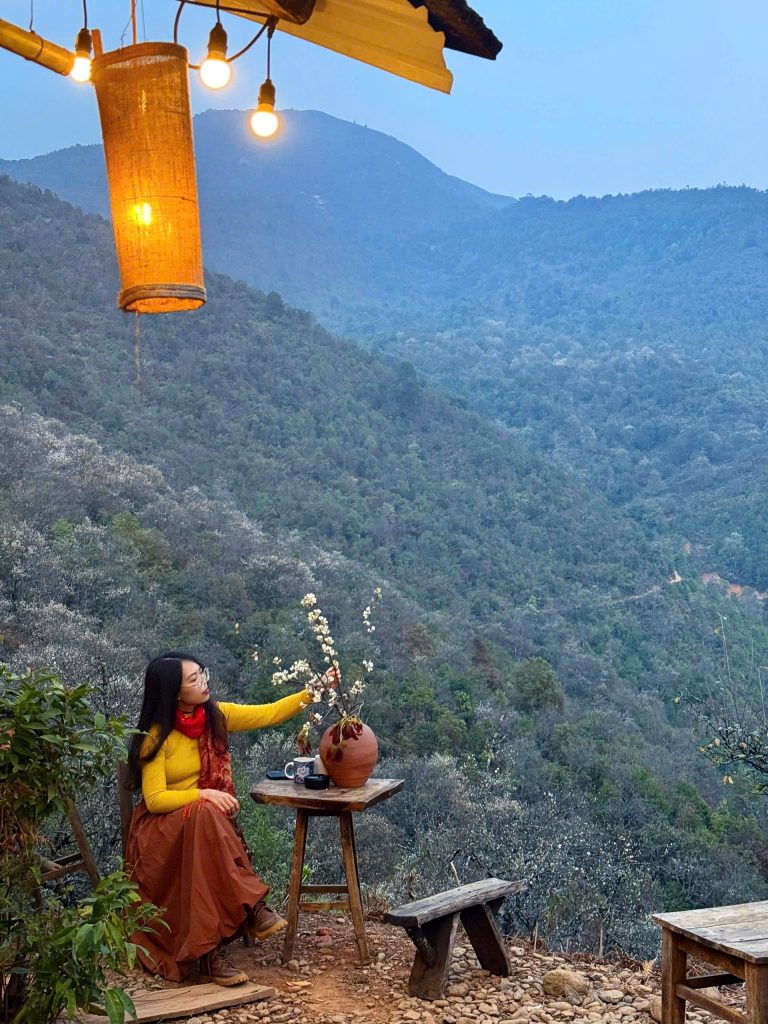
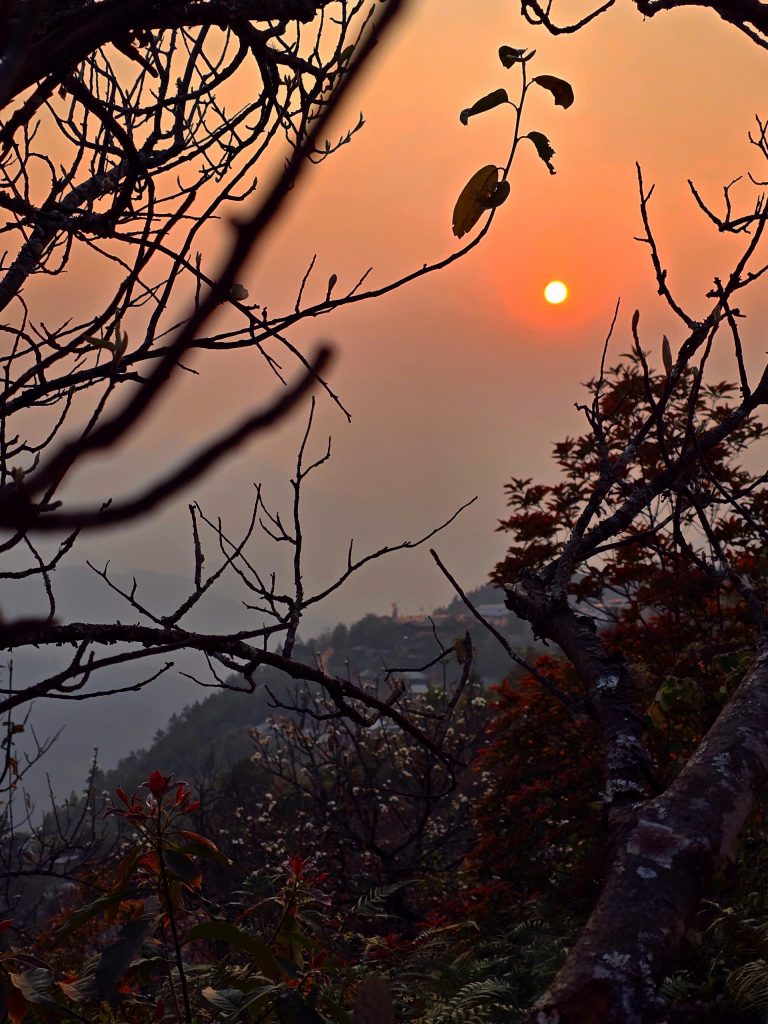
Watching the sunset from Anh Cuong’s The Lover Hill Café, sipping on the signature Son Tra tea, and discovering the mountain’s treasures — wild apple wine, apple vinegar, apple soy sauce… all crafted by the hands of the villagers. Laughter bubbles up as you play with the local children, while far off in the horizon, the sun slowly tucks itself behind the rolling hills.
As night falls, a steaming hotpot of native black chicken awaits at the homestay — a simple, soul-warming feast made even more unforgettable by the crisp chill of the highland air.
What to do in Nam Nghiep?
♥️ Check in at the dreamy Son Tra flower forest at The Lover Hill Café.
♥️ Wander through the blooming rhododendron forest atop Ta Tao Mountain.
♥️ Snap a photo with the Lonely Son Tra Tree near Ngoc Chien hydropower station.
♥️ Chase sunsets at The Lover Hill Café, Yen Ngua Hill, A Lenh Homestay, and A Vang Homestay.
♥️ Rise early for a sunrise hunt atop Mount Ta Tao.
♥️ Visit the highest café in Vietnam and capture the moment.
♥️ Stroll to the Love Stream hidden within Nam Nghiep Village.
Day 4: Nam Nghiep Village – Hanoi – Ho Chi Minh City
Wake up to a warm, hearty bowl of noodle soup with egg at the homestay.
Take a morning walk to the heart of the village to check in at the iconic Nam Nghiep Stone Pillar, and spend some time wandering through the village paths, soaking in the simple, authentic daily life of the Hmong people.
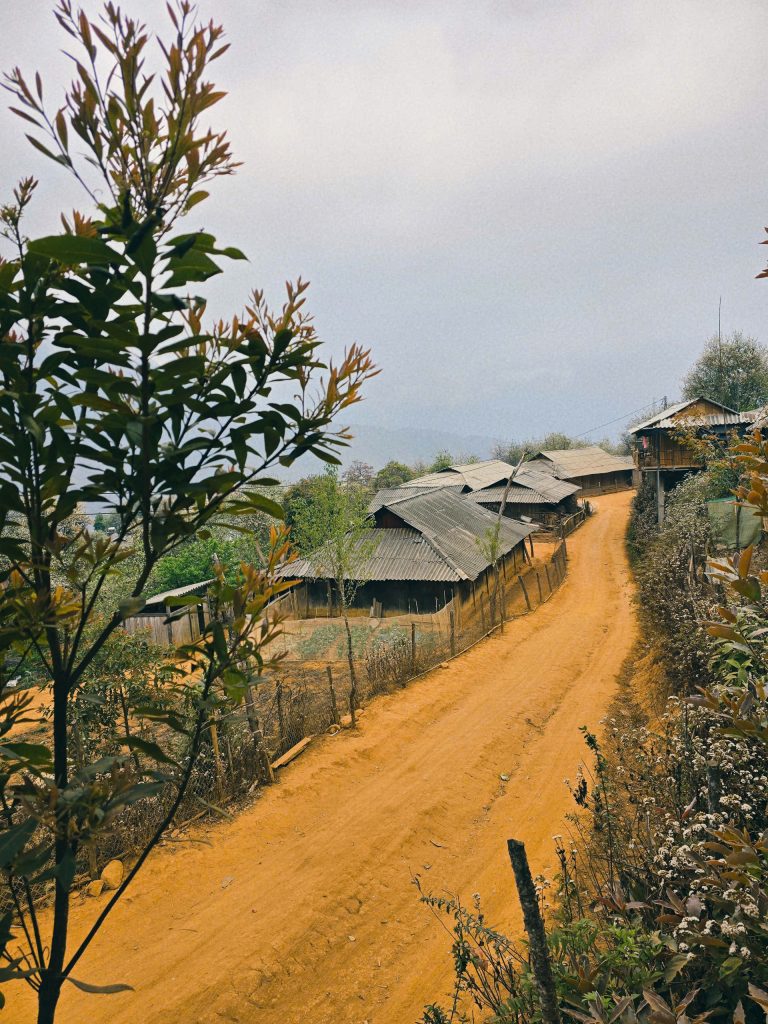

This year, the Son Tra Flower Festival was held at the Nam Nghiep Village stadium, with celebrations and activities running all the way until March 16th, 2025.
Although I arrived after the official dates, the spirit of the festival was still alive — colorful banners and signs were still fluttering across the village, warmly welcoming travelers to Nam Nghiep.

The Son Tra Flower Festival was held at the Nam Nghiep Village stadium
Checked in at the iconic Nam Nghiep Stone Pillar, then wandered through the village paths, soaking in the everyday life of the Hmong people in this peaceful corner of Nam Nghiep.
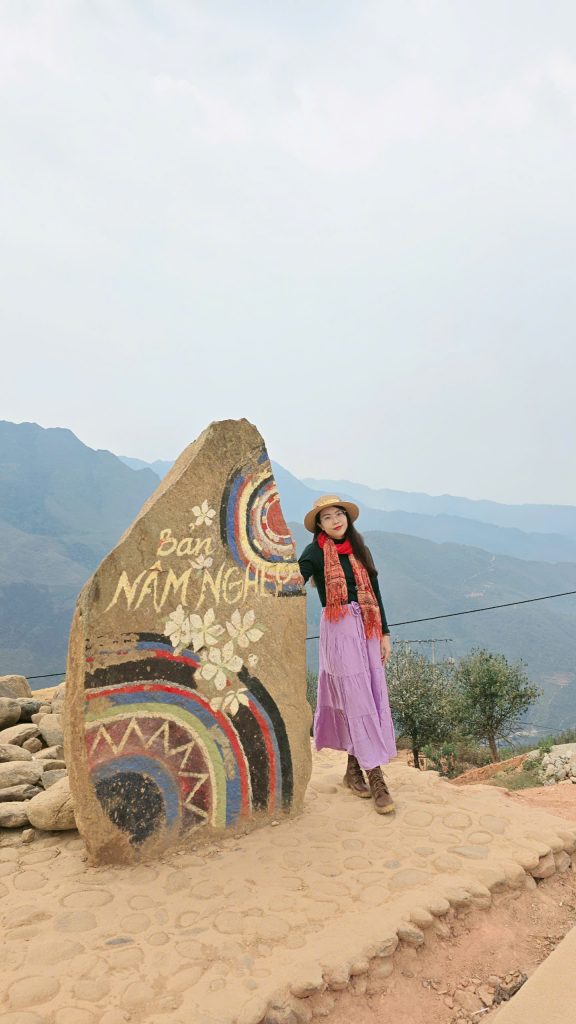
Around every corner, the spirited shouts of village children danced through the air. The Hmong women, cloaked in vibrant embroidery, wove words in a language Kame could not grasp — but the warmth needed no translation. Here, at the edge of the mountains and the world, she found herself wrapped in a raw, untamed tranquility.

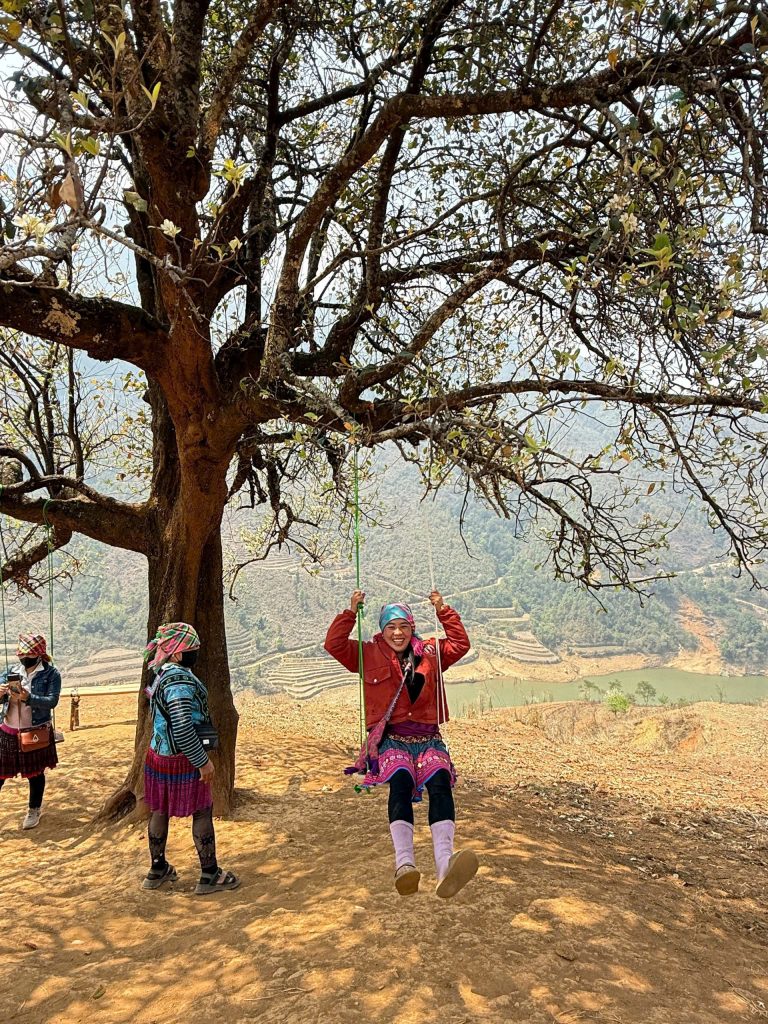
Because we were still a little obsessed with Anh Cuong’s café shop, we decided to hop on motorbike taxis and head back up there. Little did we know, right behind the café, we would stumble upon an entire forest of snow-white Son Tra blossoms — a secret spot where the local brothers often camp and pitch their tents. The scene felt straight out of a fairytale, so magical that we lost track of time, spinning around in awe and snapping photos endlessly, completely forgetting about the hour.
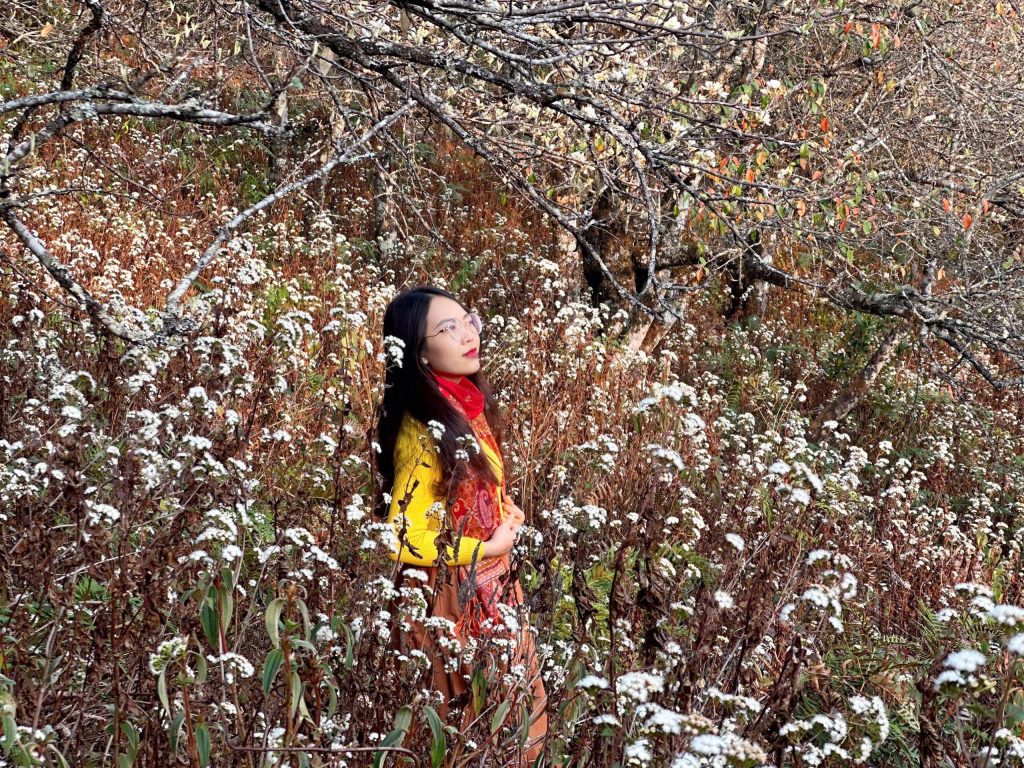
At noon, we enjoyed a warm, intimate lunch at the homestay before checking out.
To be more flexible with timing and ensure we made it back in time for our flight, we hired a private car to take us straight from Nam Nghiep Village to the airport. The cost was a bit higher, but it was well worth it — we could stop anywhere along the way to snap photos of beautiful landscapes or visit any local markets we stumbled upon for a bit of spontaneous exploring.
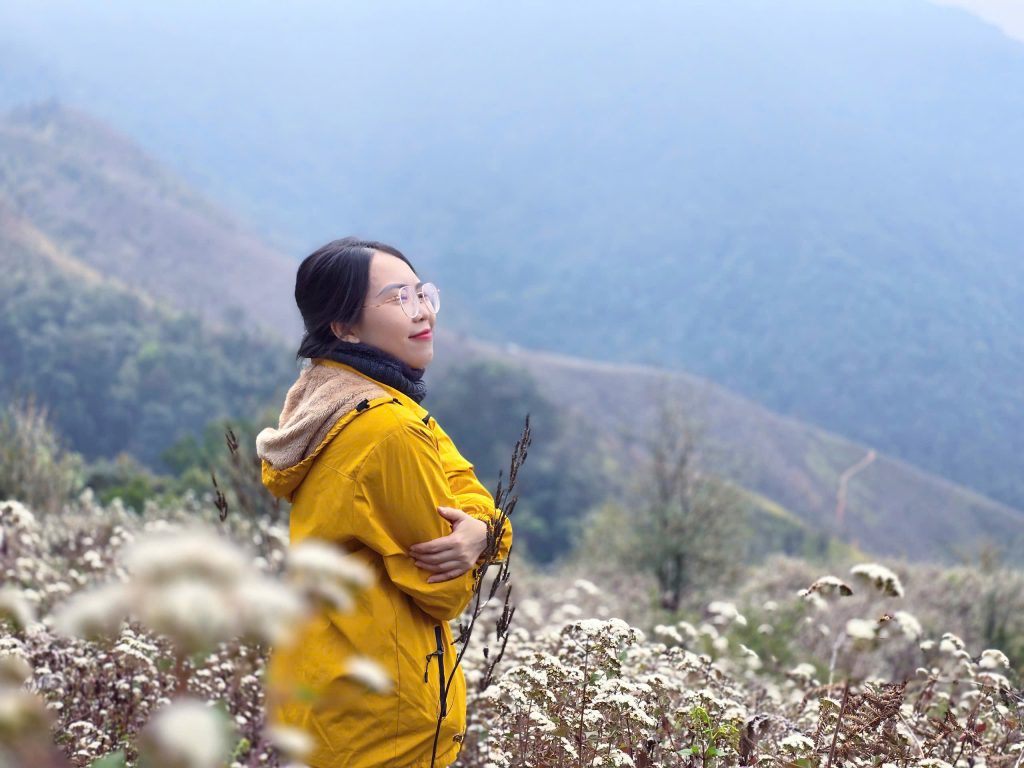
Ending the journey with the lingering scent of wildflowers and the pure white blossoms of Sơn Tra etched in my mind.
A silent promise — I will return to Nam Nghiep someday, to continue exploring all the dreams left unfinished.
A gentle reminder: as always after every adventure, leave no trace behind. Take nothing but memories and beautiful photos.
#namnghiep #namnghiep #ta_tao #namnghiep #sontraflowerseason #sontranamnghiep #reviewnamnghiep

